Paul van Yperen's Blog, page 310
May 2, 2017
Else Bassermann
Else Bassermann, née Elisabeth Sara Schiff (1878-1961) was a German stage and screen actress. In 1908 she married renowned stage actor Albert Bassermann and often performed together with him on stage. When he started to play in film, she accompanied him there too. She also wrote several scripts for his silent films.
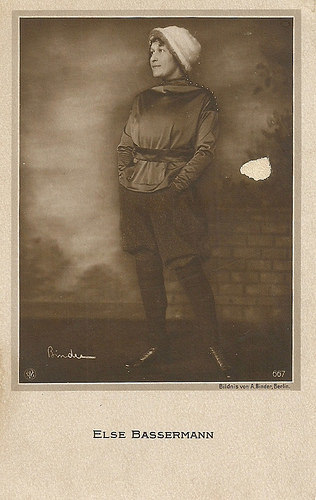
German postcard by NPG (Neue Photographische Gesellschaft), no. 667. Photo: Alex Binder, Berlin.
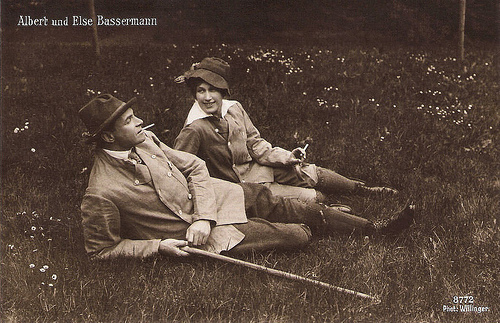
German postcard, no. 8772. Photo: Willinger. Albert and Else Bassermann.
Actress, Script-writer, Wife
Else Bassermann was born Elisabeth Sara Schiff in 1878 in Leipzig, Germany.
Else made her stage debut at the Köln Residenztheater in 1902. One year later she acted in Nuremberg before she went to Berlin in 1904, among others working at the Lessingtheater and for Max Reinhardt.
In 1908, Else married renowned stage actor Albert Bassermann and she often performed together with him on stage. When her husband started to play in film, she accompanied him, as in Der letzte Tag/The Last Day (Max Mack, 1913), ptoduced by the Vitascope company.
Under the pseudonym of Hans Hennings she wrote the scripts for several of her husband's films in the period 1917-1921, which were produced by Jules Greenbaum. She also had substantial supporting parts in them. Examples are Herr und Diener/Master and Servant (Adolf Gärtner, 1917), Du sollst keine andern Götter haben/Thou shalt have no other gods (Adolf Gärtner, 1917), and Dr. Schotte (William Wauer, 1918). The latter was found many decades later in the Desmet Collection at Eye Filmmuseum in Amsterdam.
During the 1920s, she only occasionally acted in films, mostly in bit parts in films in which her husband had major parts. Meanwhile they both continued to act on stage with great success.
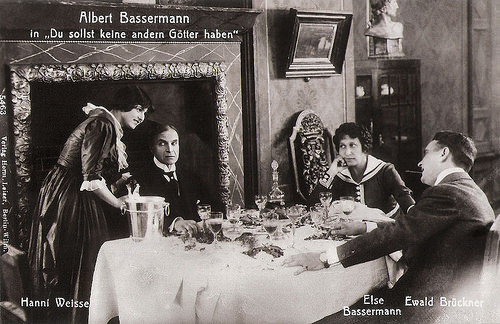
German postcard by Verlag Hermann Leiser, Berlin-Wilm., no. 5463. Photo: publicity still for Du sollst keine andern Götter haben/Thou shalt have no other gods (Adolf Gärtner, 1917) with Hanni Weisse , Albert Bassermann , Else Bassermann and Ewald Brückner.
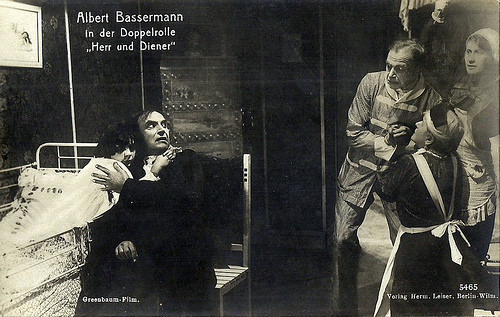
German postcard by Verlag Hermann Leiser, Berlin, no. 5465. Photo: Greenbaum-Film. Albert Bassermann in a dual role in the German silent film Herr und Diener (Adolf Gärtner, 1917). A reputed professor ( Albert Bassermann ) hires a servant (also Bassermann) for a world trip. The servant is his spitting image. When the professor is lamed, the servant trades places with him. Nobody discovers the fraud, till one day the professor's maid (Else Bassermann) unmasks the culprit. The script was written by Else Basssermann under the pseudonym of Hans Hennings. On this postcard Else Bassermann can be seen on the extreme right.
Alfred Hitchcock
In 1934 the Jewish Else Bassermann was forbidden to continue acting on stage in Germany. The couple Bassermann moved to Austria and from there, in 1939 to the USA.
In Hollywood they were employed by Warner but could make very few films. Albert could only play a few supporting parts, such as in Alfred Hitchcock's Foreign Correspondent (1940). Else also played a supporting part in Madame Curie (Mervyn LeRoy, 1943), featuring Greer Garson, and in I Was a Criminal (Richard Oswald, 1945).
Albert Bassermann 's lack of mastering the English language no doubt was an obstacle. After the war the couple returned to Europe to act on stage again, in Germany as of 1949. She did no longer take part in films.
After Albert died during a flight in a plane in 1952, Else continued to act but her career went downhill, and so went her finances. In the end she even had to give up her house, and move in with a crippled lady, together with her mentally handicapped daughter Carmen.
Else Bassermann died poor and destitute 1961 in Baden-Baden, Germany. She was 83. Her daughter died in 1971 in a traffic accident.
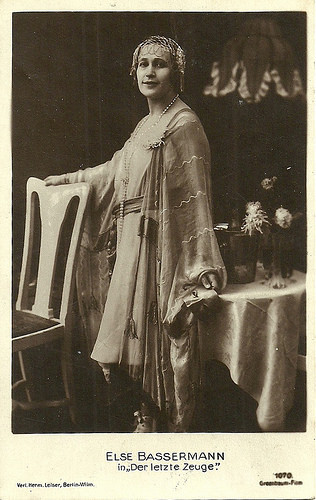
German postcard by Verlag Herman Leiser, no. 1070. Photo: Greenbaum-Film. Publicity still of Else Bassermann in Der letzte Zeuge (Adolf Gärtner, 1919).
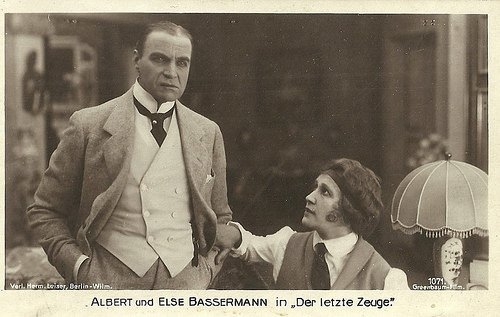
German postcard by Verlag Herman Leiser, no. 1071. Photo: Greenbaum-Film. Publicity still of Albert Bassermann and Else Bassermann in Der letzte Zeuge (Adolf Gärtner, 1919).
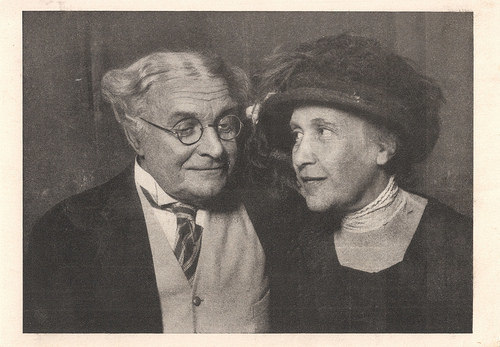
German postcard. Publicity card for Albert and Else Bassermann in the play Groszstadtluft in the Berlin theatre Scala.
Sources: Filmportal.de (German), Wikipedia (German) and .

German postcard by NPG (Neue Photographische Gesellschaft), no. 667. Photo: Alex Binder, Berlin.

German postcard, no. 8772. Photo: Willinger. Albert and Else Bassermann.
Actress, Script-writer, Wife
Else Bassermann was born Elisabeth Sara Schiff in 1878 in Leipzig, Germany.
Else made her stage debut at the Köln Residenztheater in 1902. One year later she acted in Nuremberg before she went to Berlin in 1904, among others working at the Lessingtheater and for Max Reinhardt.
In 1908, Else married renowned stage actor Albert Bassermann and she often performed together with him on stage. When her husband started to play in film, she accompanied him, as in Der letzte Tag/The Last Day (Max Mack, 1913), ptoduced by the Vitascope company.
Under the pseudonym of Hans Hennings she wrote the scripts for several of her husband's films in the period 1917-1921, which were produced by Jules Greenbaum. She also had substantial supporting parts in them. Examples are Herr und Diener/Master and Servant (Adolf Gärtner, 1917), Du sollst keine andern Götter haben/Thou shalt have no other gods (Adolf Gärtner, 1917), and Dr. Schotte (William Wauer, 1918). The latter was found many decades later in the Desmet Collection at Eye Filmmuseum in Amsterdam.
During the 1920s, she only occasionally acted in films, mostly in bit parts in films in which her husband had major parts. Meanwhile they both continued to act on stage with great success.

German postcard by Verlag Hermann Leiser, Berlin-Wilm., no. 5463. Photo: publicity still for Du sollst keine andern Götter haben/Thou shalt have no other gods (Adolf Gärtner, 1917) with Hanni Weisse , Albert Bassermann , Else Bassermann and Ewald Brückner.

German postcard by Verlag Hermann Leiser, Berlin, no. 5465. Photo: Greenbaum-Film. Albert Bassermann in a dual role in the German silent film Herr und Diener (Adolf Gärtner, 1917). A reputed professor ( Albert Bassermann ) hires a servant (also Bassermann) for a world trip. The servant is his spitting image. When the professor is lamed, the servant trades places with him. Nobody discovers the fraud, till one day the professor's maid (Else Bassermann) unmasks the culprit. The script was written by Else Basssermann under the pseudonym of Hans Hennings. On this postcard Else Bassermann can be seen on the extreme right.
Alfred Hitchcock
In 1934 the Jewish Else Bassermann was forbidden to continue acting on stage in Germany. The couple Bassermann moved to Austria and from there, in 1939 to the USA.
In Hollywood they were employed by Warner but could make very few films. Albert could only play a few supporting parts, such as in Alfred Hitchcock's Foreign Correspondent (1940). Else also played a supporting part in Madame Curie (Mervyn LeRoy, 1943), featuring Greer Garson, and in I Was a Criminal (Richard Oswald, 1945).
Albert Bassermann 's lack of mastering the English language no doubt was an obstacle. After the war the couple returned to Europe to act on stage again, in Germany as of 1949. She did no longer take part in films.
After Albert died during a flight in a plane in 1952, Else continued to act but her career went downhill, and so went her finances. In the end she even had to give up her house, and move in with a crippled lady, together with her mentally handicapped daughter Carmen.
Else Bassermann died poor and destitute 1961 in Baden-Baden, Germany. She was 83. Her daughter died in 1971 in a traffic accident.

German postcard by Verlag Herman Leiser, no. 1070. Photo: Greenbaum-Film. Publicity still of Else Bassermann in Der letzte Zeuge (Adolf Gärtner, 1919).

German postcard by Verlag Herman Leiser, no. 1071. Photo: Greenbaum-Film. Publicity still of Albert Bassermann and Else Bassermann in Der letzte Zeuge (Adolf Gärtner, 1919).

German postcard. Publicity card for Albert and Else Bassermann in the play Groszstadtluft in the Berlin theatre Scala.
Sources: Filmportal.de (German), Wikipedia (German) and .
Published on May 02, 2017 22:00
May 1, 2017
Diana Dors
Blonde and curvey bombshell Diana Dors (1931-1984) was called ‘The English Marilyn Monroe’, to her disgust. In her own words: "I was the first home-grown sex symbol, rather like Britain's naughty seaside postcards. When Marilyn Monroe's first film was shown here [The Asphalt Jungle (1950)], a columnist actually wrote, 'How much like our Diana Dors she is'."
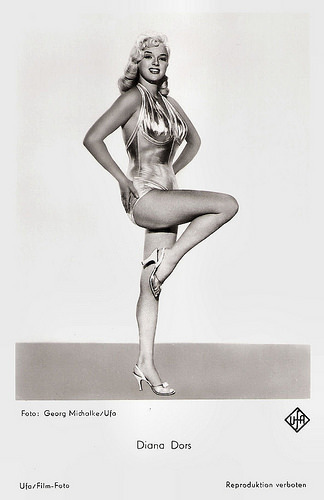
German postcard by Ufa, Berlin-Tempelhof, no. FK 3954. Photo: Georg Michalke / Ufa.
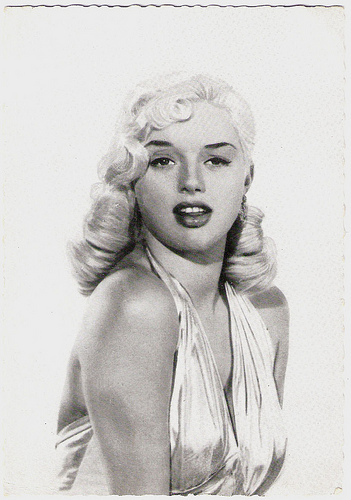
German postcard by Filmbilder-Vertrieb Ernst Freihoff, Essen, no. 245. Retail prive: 10 Pfg. Photo: Georg Michalke.
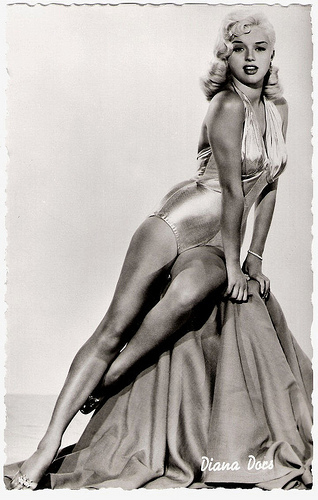
Austrian postcard by Bild- und Ton-Postkartenverlag P. Weizmann, Wien, no. 570. Photo: Georg Michalke.
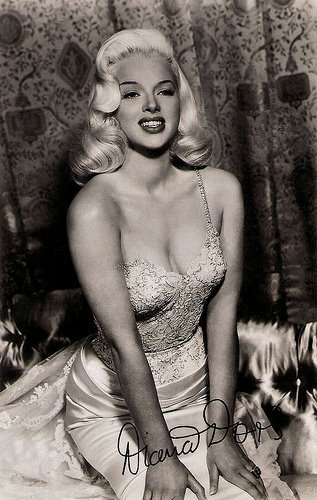
British promo card for Empire News and Sunday Chronicle. The card announced that Diana Dors would write a series of articles for the two-in-one Sunday newspaper about her adventures in Hollywood. In Hollywood she made The Unholy Wife (John Farrow, 1957) and I Married a Woman (Hal Kanter, 1958). The latter was filmed between mid-July and late August 1956 and the card was probably produced in 1956 or 1957.
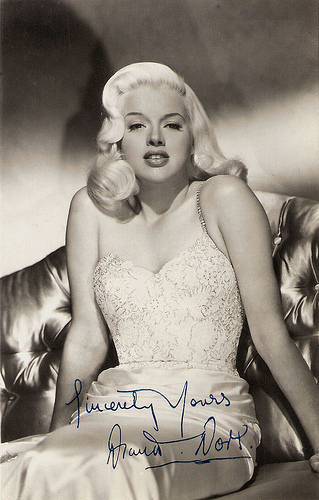
British autograph card. Photo: Cornel Lucas / Rank.
The Siren of Swindon
Diana Dors was born Diana Mary Fluck in Swindon, England, in 1931. Her father, Peter Fluck, was a railroad employee. Her mother, Mary Fluck, had almost died from the traumatic birth of her daughter. Because of this trauma, she lavished on Diana everything she herself had dreamed of: clothes, dance lessons, visits to the cinema. The actresses on the screen caught Diana's attention and she later told that she wanted to be an actress from the age of three.
Physically, Diana grew up fast and she looked and acted much older than what she was. 'The Siren of Swindon' began her career on stage while she was only 13. The youngest of her class, she trained at the London Academy of Music and Dramatic Arts (LAMDA) in London.
At the age of 15, she appeared in her first film, The Shop at Sly Corner (George King, 1947) starring Oskar Homolka . The J. Arthur Rank Organisation offered her a contract and she played several ‘sexy girl in background’ roles in their films. The best of these parts was Charlotte in Oliver Twist (David Lean, 1948) starring Alec Guinness .
She made several more films in the late 1940s, including substantial roles in the comedy Here Come The Huggetts (Ken Annakin, 1948), and the 'bad girl' opposite Honor Blackman 's more virtuous roles in the cycling comedy A Boy, a Girl and a Bike (Ralph Smart, 1949) and Diamond City (David MacDonald, 1949), a lively British 'Western' set in South Africa's diamond fields.
Her appeal stemmed from a combination of glamour and humour, coupled with a lack of vanity. A good example of her early appeal comes in Lady Godiva Rides Again (Frank Launder, 1951) with Dennis Price . It was a light hearted romp that made fun of the beauty queen business. The American Board of Film Censors had banned the film because Diana was showing her navel. However she's friendly and surprisingly non-threatening in the film, more interested in having fun than in winning. Both critics and the public loved her as a sexy siren.
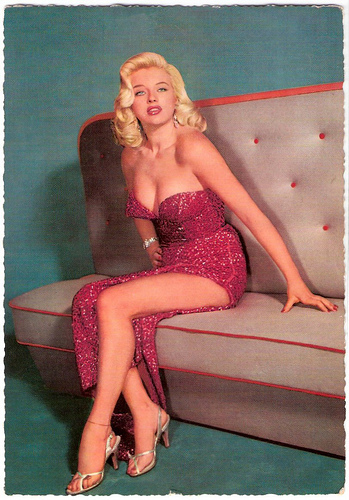
German card, printed by Krüger, no. 902/80. Photo: Ufa.
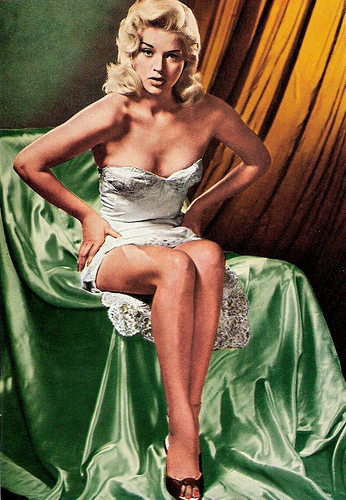
German postcard by Terra-Colour, no. PU 4.
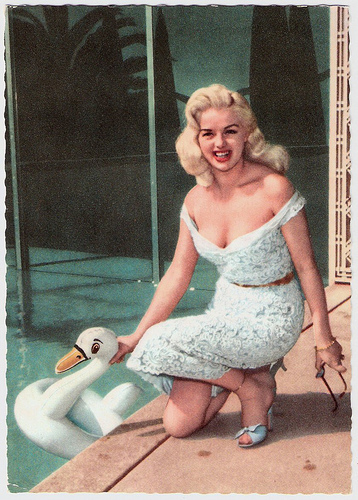
German postcard by Ufa (Universum-Film Aktiengesellschaft), Berlin Tempelhof, no. CK-86. Retail price: 30 Pfg. Photo: Ufa.
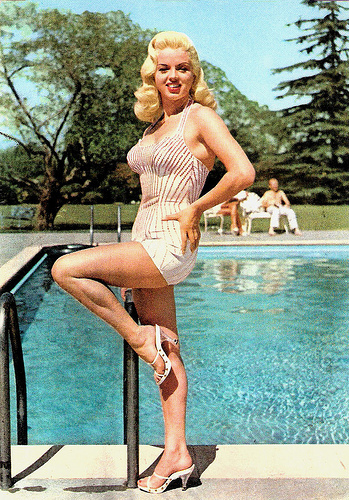
Italian postcard by Rotalcolor, no. 18.
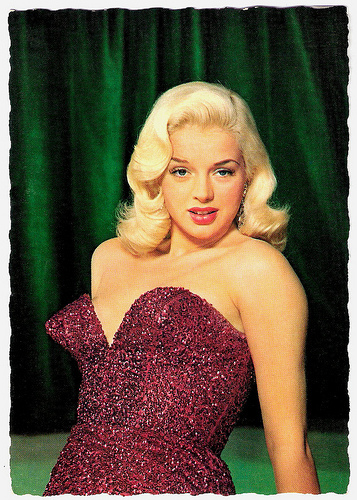
French postcard by E.D.U.G., no. 53.
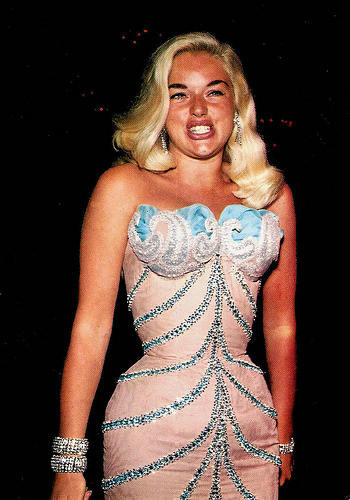
Spanish postcard by Oscarcolor, no. 331.
Public Brawl
Diana Dors was one of the very first celebrities to actually court the British press. Her first husband and manager Dennis Hamilton believed any publicity either good or bad could only benefit the ambitious starlet. One stunt was to set up the company Diana Dors Ltd and another was the announcement of Diana as the youngest Rolls Royce owner at the age of 20 (however, she could not drive).
Dors got a 'decent' role in the 'women in prison' drama The Weak and the Wicked (J. Lee Thompson, 1954) opposite Glynis Johns and people started to believe she could act as well as look decorative. She confirmed her talent with a good role in the fantasy A Kid for Two Farthings (Carol Reed, 1955) with Celia Johnson , and her part as a murderess in Yield to the Night (J. Lee Thompson, 1956), loosely based on the true life story of Ruth Ellis, the last woman executed in Britain for murder.
Casting off her sex symbol image, Diana portrayed Mary Hilton whose story is told entirely in flashbacks, as she awaits her final sentencing or possible reprieve, and attempts to tie up the loose ends in her life involving her mother, brother, and husband. Michael Brooke writes at BFI Screenonline : "Eyebrows were raised at Dors being offered such a challenging dramatic role, given that her blonde bombshell image at the time was almost exclusively associated with comedy, but she rose to the occasion, managing to evoke considerable sympathy for her condemned but essentially unsympathetic character."
Dors was snapped up by Hollywood, but she was put in two unsuitable vehicles, the crime thriller The Unholy Wife (John Farrow, 1957) with Rod Steiger, and the comedy I Married a Woman (Hal Kanter, 1958).
A very public brawl between her and her husband, Dennis Hamilton, finished her Hollywood career. At a pool party full of Hollywood A-list celebrities, Diana was pushed fully clothed into her swimming pool. Hamilton then proceeded to punch the photographer thought to have pushed her into unconsciousness. The celebrities fled and the headlines the following day were 'Ms Dors go home and take Mr Dors with you!'. Her three movie deal with RKO ended after they cancelled the contract on a moral clause in the contract.
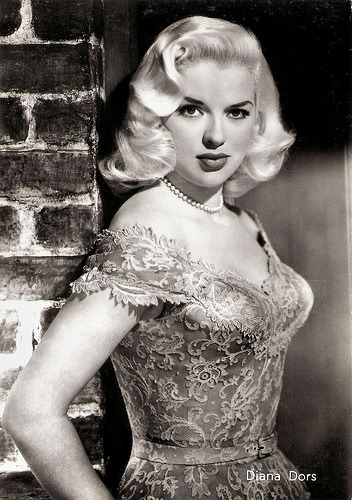
Italian postcard by Bromostampa, Milano, no. 10.
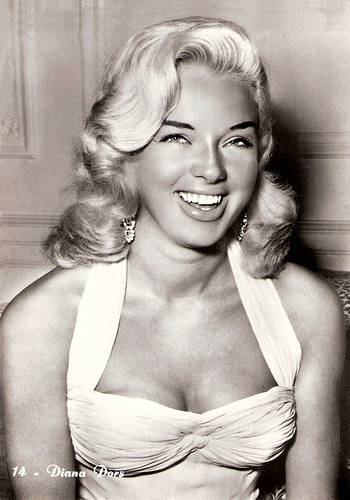
Italian postcard by Turismofoto, no. 14.
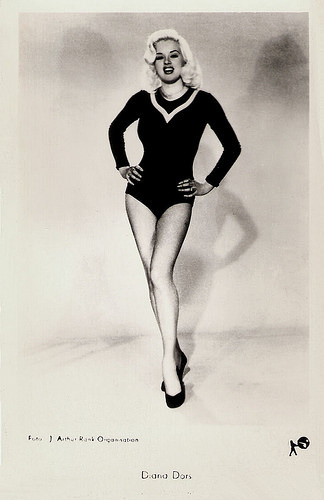
French postcard by Editions P.I., Paris, no. FK 3860. Photo: J. Arthur Rank Organisation.
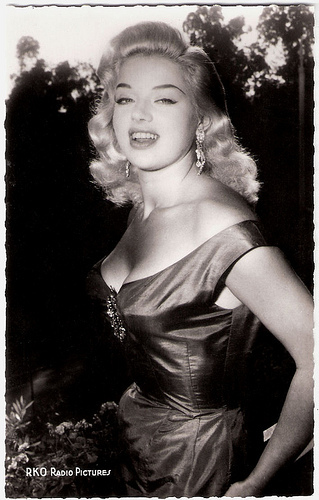
French postcard by Editions du Globe, no. 559. Photo: RKO Radio Pictures.
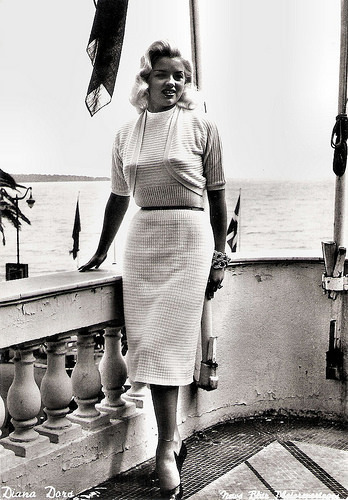
Italian postcard by Bromofoto, Milano, no. 1251.
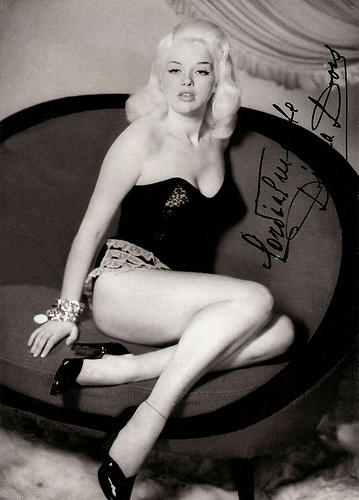
Italian photo distributed at Quindicinale fotografico d'attualita cine-teatrale, Roma.
Blowsy
Diana Dors returned to Britain, but she never quite attained the level of her pre-Hollywood period. During the 1960s Dors never stopped working but her roles got smaller and the films worse. In the campy horror film Beserk! (Jim O'Connolly, 1967), she played a performer in a cheesy carnival who ends up cut in half by a power saw. The film starred 63-year-old Joan Crawford who played the outrageous owner and ringmaster of a travelling circus, who'll stop at nothing to draw bigger audiences...
Dors was often seen on TV both in the US and the UK. She began to pile on the pounds and rapidly went from blowsy to fat. One of her weighty roles was as the ex-wife of Peter Sellers in There's a Girl in My Soup (Roy Boulting, 1970). Her appearance in The Amazing Mr Blunden (Lionel Jeffries, 1972) got a lot of publicity as she played a slatternly Victorian housekeeper in her sixties.
Her major television breakthrough came in 1970, when she starred as a brassy matriarch in Keith Waterhouse and Willis Hall's popular ITV sitcom Queenie's Castle (1970-1972). Despite these successes she continued to accept any role going and took small parts in several British sex comedies, such as Adventures of a Taxi Driver (Stanley Long, 1976).
Diana Dors died in 1984 from a recurrence of ovarian cancer, first diagnosed two years earlier. She was 52 years old. For over thirty years she had lived her life in the headlines, and now she was missed. She had three sons, Mark and Gary Dawson from her second marriage to comedian/TV emcee Richard Dawson, and Jason Lake from her third marriage to actor Alan Lake. Alan Lake committed suicide not long after her death, which generated even more headlines.
Her final film, the Nell Dunn adaptation Steaming (Joseph Losey, 1985) starring Vanessa Redgrave , was released a year later. During her career of nearly four decades, Diana Dors was loved by the British public, and her life, both professional and personal, was followed in a whole new way. Through the media, her life was made accessible to the British public: she was down to earth, made mistakes, had a vulnerability about her and the public followed her ups and downs through the many daily newspapers and magazine articles.
Together with 'The Three M's' from Hollywood: Jayne Mansfield , Mamie Van Doren and Marilyn Monroe , DD has left her mark on popular culture by popularising the 1950s blonde bombshell look. As David Absalom at British Pictures writes: "She's been a National Joke and a National Disgrace in her time, but when she died we realised we'd lost a National Treasure."
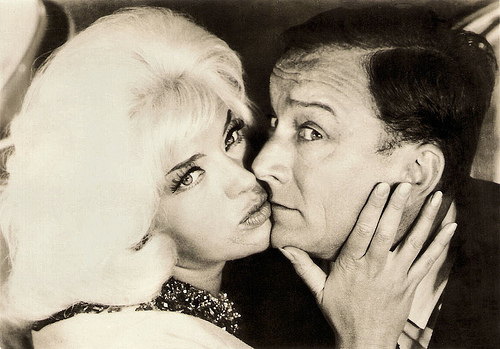
East-German postcard by VEB Progress Film-Vertrieb, Berlin, no. 2629. Photo: publicity still for Allez France!/The Counterfeit Constable (Robert Dhéry, Pierre Tchernia, 1964) with Robert Dhèry.
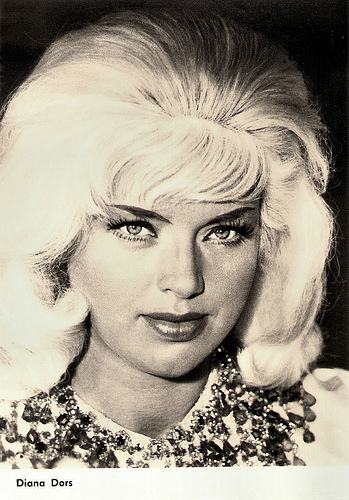
East-German postcard by VEB Progress Filmvertrieb, Berlin, no. 2.631, 1966. Photo: publicity still for Allez France!/The Counterfeit Constable (Robert Dhéry, Pierre Tchernia, 1964).
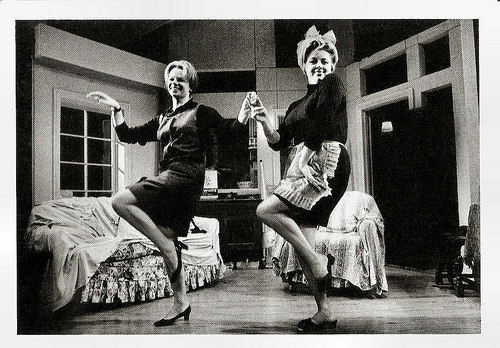
British postcard in the series Talking the Stage: an exhibition of photographs by John Haynes by National Theatre (NT). Photo: John Haynes. Publicity still for Three Months Gone by Donald Howarth (1970) with Jill Bennett.
Trailer for The Unholy Wife (1957). Source: Pinkfairygirl86 (YouTube).
Trailer for Beserk! (1967). Source: SonyPicsHomeEntAU (YouTube).
Sources: Michael Brooke (BFI Screenonline), David Absalom (British Pictures), Hal Erickson (AllMovie), (IMDb), DianaDors.com, Wikipedia, and .

German postcard by Ufa, Berlin-Tempelhof, no. FK 3954. Photo: Georg Michalke / Ufa.

German postcard by Filmbilder-Vertrieb Ernst Freihoff, Essen, no. 245. Retail prive: 10 Pfg. Photo: Georg Michalke.

Austrian postcard by Bild- und Ton-Postkartenverlag P. Weizmann, Wien, no. 570. Photo: Georg Michalke.

British promo card for Empire News and Sunday Chronicle. The card announced that Diana Dors would write a series of articles for the two-in-one Sunday newspaper about her adventures in Hollywood. In Hollywood she made The Unholy Wife (John Farrow, 1957) and I Married a Woman (Hal Kanter, 1958). The latter was filmed between mid-July and late August 1956 and the card was probably produced in 1956 or 1957.

British autograph card. Photo: Cornel Lucas / Rank.
The Siren of Swindon
Diana Dors was born Diana Mary Fluck in Swindon, England, in 1931. Her father, Peter Fluck, was a railroad employee. Her mother, Mary Fluck, had almost died from the traumatic birth of her daughter. Because of this trauma, she lavished on Diana everything she herself had dreamed of: clothes, dance lessons, visits to the cinema. The actresses on the screen caught Diana's attention and she later told that she wanted to be an actress from the age of three.
Physically, Diana grew up fast and she looked and acted much older than what she was. 'The Siren of Swindon' began her career on stage while she was only 13. The youngest of her class, she trained at the London Academy of Music and Dramatic Arts (LAMDA) in London.
At the age of 15, she appeared in her first film, The Shop at Sly Corner (George King, 1947) starring Oskar Homolka . The J. Arthur Rank Organisation offered her a contract and she played several ‘sexy girl in background’ roles in their films. The best of these parts was Charlotte in Oliver Twist (David Lean, 1948) starring Alec Guinness .
She made several more films in the late 1940s, including substantial roles in the comedy Here Come The Huggetts (Ken Annakin, 1948), and the 'bad girl' opposite Honor Blackman 's more virtuous roles in the cycling comedy A Boy, a Girl and a Bike (Ralph Smart, 1949) and Diamond City (David MacDonald, 1949), a lively British 'Western' set in South Africa's diamond fields.
Her appeal stemmed from a combination of glamour and humour, coupled with a lack of vanity. A good example of her early appeal comes in Lady Godiva Rides Again (Frank Launder, 1951) with Dennis Price . It was a light hearted romp that made fun of the beauty queen business. The American Board of Film Censors had banned the film because Diana was showing her navel. However she's friendly and surprisingly non-threatening in the film, more interested in having fun than in winning. Both critics and the public loved her as a sexy siren.

German card, printed by Krüger, no. 902/80. Photo: Ufa.

German postcard by Terra-Colour, no. PU 4.

German postcard by Ufa (Universum-Film Aktiengesellschaft), Berlin Tempelhof, no. CK-86. Retail price: 30 Pfg. Photo: Ufa.

Italian postcard by Rotalcolor, no. 18.

French postcard by E.D.U.G., no. 53.

Spanish postcard by Oscarcolor, no. 331.
Public Brawl
Diana Dors was one of the very first celebrities to actually court the British press. Her first husband and manager Dennis Hamilton believed any publicity either good or bad could only benefit the ambitious starlet. One stunt was to set up the company Diana Dors Ltd and another was the announcement of Diana as the youngest Rolls Royce owner at the age of 20 (however, she could not drive).
Dors got a 'decent' role in the 'women in prison' drama The Weak and the Wicked (J. Lee Thompson, 1954) opposite Glynis Johns and people started to believe she could act as well as look decorative. She confirmed her talent with a good role in the fantasy A Kid for Two Farthings (Carol Reed, 1955) with Celia Johnson , and her part as a murderess in Yield to the Night (J. Lee Thompson, 1956), loosely based on the true life story of Ruth Ellis, the last woman executed in Britain for murder.
Casting off her sex symbol image, Diana portrayed Mary Hilton whose story is told entirely in flashbacks, as she awaits her final sentencing or possible reprieve, and attempts to tie up the loose ends in her life involving her mother, brother, and husband. Michael Brooke writes at BFI Screenonline : "Eyebrows were raised at Dors being offered such a challenging dramatic role, given that her blonde bombshell image at the time was almost exclusively associated with comedy, but she rose to the occasion, managing to evoke considerable sympathy for her condemned but essentially unsympathetic character."
Dors was snapped up by Hollywood, but she was put in two unsuitable vehicles, the crime thriller The Unholy Wife (John Farrow, 1957) with Rod Steiger, and the comedy I Married a Woman (Hal Kanter, 1958).
A very public brawl between her and her husband, Dennis Hamilton, finished her Hollywood career. At a pool party full of Hollywood A-list celebrities, Diana was pushed fully clothed into her swimming pool. Hamilton then proceeded to punch the photographer thought to have pushed her into unconsciousness. The celebrities fled and the headlines the following day were 'Ms Dors go home and take Mr Dors with you!'. Her three movie deal with RKO ended after they cancelled the contract on a moral clause in the contract.

Italian postcard by Bromostampa, Milano, no. 10.

Italian postcard by Turismofoto, no. 14.

French postcard by Editions P.I., Paris, no. FK 3860. Photo: J. Arthur Rank Organisation.

French postcard by Editions du Globe, no. 559. Photo: RKO Radio Pictures.

Italian postcard by Bromofoto, Milano, no. 1251.

Italian photo distributed at Quindicinale fotografico d'attualita cine-teatrale, Roma.
Blowsy
Diana Dors returned to Britain, but she never quite attained the level of her pre-Hollywood period. During the 1960s Dors never stopped working but her roles got smaller and the films worse. In the campy horror film Beserk! (Jim O'Connolly, 1967), she played a performer in a cheesy carnival who ends up cut in half by a power saw. The film starred 63-year-old Joan Crawford who played the outrageous owner and ringmaster of a travelling circus, who'll stop at nothing to draw bigger audiences...
Dors was often seen on TV both in the US and the UK. She began to pile on the pounds and rapidly went from blowsy to fat. One of her weighty roles was as the ex-wife of Peter Sellers in There's a Girl in My Soup (Roy Boulting, 1970). Her appearance in The Amazing Mr Blunden (Lionel Jeffries, 1972) got a lot of publicity as she played a slatternly Victorian housekeeper in her sixties.
Her major television breakthrough came in 1970, when she starred as a brassy matriarch in Keith Waterhouse and Willis Hall's popular ITV sitcom Queenie's Castle (1970-1972). Despite these successes she continued to accept any role going and took small parts in several British sex comedies, such as Adventures of a Taxi Driver (Stanley Long, 1976).
Diana Dors died in 1984 from a recurrence of ovarian cancer, first diagnosed two years earlier. She was 52 years old. For over thirty years she had lived her life in the headlines, and now she was missed. She had three sons, Mark and Gary Dawson from her second marriage to comedian/TV emcee Richard Dawson, and Jason Lake from her third marriage to actor Alan Lake. Alan Lake committed suicide not long after her death, which generated even more headlines.
Her final film, the Nell Dunn adaptation Steaming (Joseph Losey, 1985) starring Vanessa Redgrave , was released a year later. During her career of nearly four decades, Diana Dors was loved by the British public, and her life, both professional and personal, was followed in a whole new way. Through the media, her life was made accessible to the British public: she was down to earth, made mistakes, had a vulnerability about her and the public followed her ups and downs through the many daily newspapers and magazine articles.
Together with 'The Three M's' from Hollywood: Jayne Mansfield , Mamie Van Doren and Marilyn Monroe , DD has left her mark on popular culture by popularising the 1950s blonde bombshell look. As David Absalom at British Pictures writes: "She's been a National Joke and a National Disgrace in her time, but when she died we realised we'd lost a National Treasure."

East-German postcard by VEB Progress Film-Vertrieb, Berlin, no. 2629. Photo: publicity still for Allez France!/The Counterfeit Constable (Robert Dhéry, Pierre Tchernia, 1964) with Robert Dhèry.

East-German postcard by VEB Progress Filmvertrieb, Berlin, no. 2.631, 1966. Photo: publicity still for Allez France!/The Counterfeit Constable (Robert Dhéry, Pierre Tchernia, 1964).

British postcard in the series Talking the Stage: an exhibition of photographs by John Haynes by National Theatre (NT). Photo: John Haynes. Publicity still for Three Months Gone by Donald Howarth (1970) with Jill Bennett.
Trailer for The Unholy Wife (1957). Source: Pinkfairygirl86 (YouTube).
Trailer for Beserk! (1967). Source: SonyPicsHomeEntAU (YouTube).
Sources: Michael Brooke (BFI Screenonline), David Absalom (British Pictures), Hal Erickson (AllMovie), (IMDb), DianaDors.com, Wikipedia, and .
Published on May 01, 2017 22:00
April 30, 2017
Katharina Thalbach
Katharina Thalbach (1954) is one of Germany's most respected stage actresses mostly working in Hamburg and Berlin. Internationally, she is best known for her part in Die Blechtrommel/The Tin Drum (1979), Volker Schlöndorf’s award-winning film adaptation of the novel by Günter Grass. She has also directed since the late 1980s.

East-German postcard by VEB Progress Film-Vertrieb, Berlin, no. 143/72. Photo: Blasig. Publicity still for Es ist eine alte Geschichte/It Is an Old Story (Lothar Warneke, 1972).

East-German postcard by VEB Progress Film-Vertrieb, Berlin, no. 31/74. Photo: Blasig.
Banned in Oklahoma
Katharina Thalbach was born in 1954 in East Berlin, East-Germany. She comes from a particularly artistically oriented family. Her father Benno Besson was a director, her mother Sabine Thalbach was an actress.
She grew up in the theatre while her mother worked for the Berliner Ensemble and the Deutschen Theater. At the age of four, she made her screen debut in the TV film Begegnung im Dunkel/Meeting in the Dark (1958). Her half-brother Pierre Besson and her stepmother Ursula Karusseit are both also actors.
After the death of her mother in 1966, actress Helene Weigel took Katharina under her wings. During her school years, Thalbach’s acting teacher was Doris Thalmer. At 15, she made her stage debut as the whore Betty in Erich Engels' version of Die Dreigroschenoper (The Three Penny Opera) in 1969, and later took over the leading role of Polly. She is considered as a new talent and continued to perform at the Berliner Ensemble.
With her other half-brother Benjamin Besson, she played in the DEFA film Es ist eine alte Geschichte/It Is an Old Story (Lothar Warneke, 1972). In 1975, she appeared in another DEFA production Lotte in Weimar (Egon Günther, 1975), starring Lilli Palmer and based on the novel by Thomas Mann.
In December 1976, she left East Germany together with longtime companion Thomas Brasch and daughter Anna after the expulsion of songwriter Wolf Biermann. She then played a supporting part in the West-German drama Das zweite Erwachen der Christa Klages/The Second Awakening of Christa Klages (1978) directed by Margarethe von Trotta, her debut solo film.
The following year, she became known for her role in Die Blechtrommel/The Tin Drum (Volker Schlöndorff, 1979), the film adaptation of the novel by Günter Grass, which won the Palme d'Or at the 1979 Cannes Film Festival and the 1980 Oscar for Best Foreign Language Film.
The film lead to a ban in Oklahoma because of scenes in which lead actor David Bennent, then 11 years of age and playing a stunted 16-year-old, licks effervescing sherbet powder from the navel of a 16-year-old girl, played by Thalbach, who was 24 years old at the time. Subsequently, Bennent appears to have oral sex and then intercourse with her. The Ontario Censor Board in Canada first cut the film and then banned it as child pornography.
In the multi-part television film Theodor Chindler (1979) by Hans W. Geißendörfer, she was Margarete, the young, revolutionary daughter of Reichstag deputy Theodor Chindler.
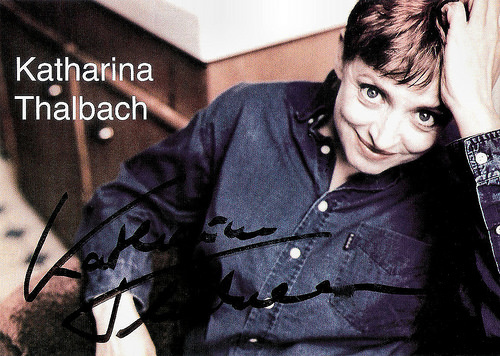
German autograph card.

German autograph card. Photo: Mathias Bothor.
Actress of the Year
Katharina Thalbach often played dominant women who rebel against society, fight against misery and take their fate into their own hands. In 1980, she was voted 'Actress of the Year' by the critics of the magazine Theater Heute for her title role in Heinrich von Kleist’s Das Käthchen von Heilbronn. She then co-starred with Hilmar Thate in the crime film Engel aus Eisen/Angels of Iron (1981), directed by her partner Thomas Brasch.
She played a supporting part in the American drama Sophie's Choice (Alan J. Pakula, 1982) starring Meryl Streep as Sophie. She appeared in the German-Finnish drama Flucht in den Norden/Flight North (Ingemo Engström, 1986) with Lena Olin, the German comedy Z.B. ... Otto Spalt/The Case of Mr. Spalt (René Perraudin, 1988), and in Thomas Brasch’s drama Der Passagier – Welcome to Germany/The Passenger - Welcome to Germany (1988), featuring Tony Curtis.
Thalbach co-starred with Stellan Skarsgård in the Swedish film God afton, Herr Wallenberg - En Passionshistoria från verkligheten/Good Evening, Mr. Wallenberg (Kjell Grede, 1990) about Swedish World War II diplomat Raoul Wallenberg, who was instrumental in saving the lives of thousands of Hungarian Jews from the Holocaust.
A box office hit in Germany was the comedy Sonnenallee/Sun Avenue (Leander Haußmann, 1999) about life of the East-German youth in East Berlin in the late 1970s. The Sonnenallee is an actual street in Berlin that was intersected by the border between East and West during the time of the Berlin Wall. Thalbach portrayed Doris Ehrenreich, the mother of the male main character Micha.
She appeared with Nina Hoss in Der Vulkan/The Volcano (Ottokar Runze, 1999), and also often acted for television. In the TV mini-series Die Manns – Ein Jahrhundertroman (Heinrich Breloer, 2001) about the famous literary family, she played actress Therese Giehse, partner of Erika Mann.
The international coproduction König der Diebe/King of Thieves (Ivan Fila, 2004) is a powerful indictment dealing with child slavery in the German marketplace. Thalbach had the lead role in the Polish language film Strajk - Die Heldin von Danzig/Strike (2006) directed by Volker Schlöndorff. The film is broadly a docudrama covering the formation of Solidarity, and she won the 2006Bavarian Film Award for Best Actress for it.
Her more recent German films include the tragicomedy Der Mond und andere Liebhaber/The Moon and Other Lovers (Bernd Böhlich, 2008), and the fantasy film Rubinrot/Ruby Red (Felix Fuchssteiner, 2013). Katharina Thalback continues to play theatre, film and television. Her daughter Anna, born in 1973 from a relationship with actor Vladimir Weigl, and her granddaughter Nellie (born 1995) are also actresses.
Trailer Die Blechtrommel/The Tin Drum (1979). Source: DionysusCinema (YouTube).
Trailer Sonnenallee/Sun Avenue (1999). Source: moviemaniacsDE (YouTube).
Sources: Hans-Michael Bock (Cinegraph- German), Wikipedia (English and German), and .

East-German postcard by VEB Progress Film-Vertrieb, Berlin, no. 143/72. Photo: Blasig. Publicity still for Es ist eine alte Geschichte/It Is an Old Story (Lothar Warneke, 1972).

East-German postcard by VEB Progress Film-Vertrieb, Berlin, no. 31/74. Photo: Blasig.
Banned in Oklahoma
Katharina Thalbach was born in 1954 in East Berlin, East-Germany. She comes from a particularly artistically oriented family. Her father Benno Besson was a director, her mother Sabine Thalbach was an actress.
She grew up in the theatre while her mother worked for the Berliner Ensemble and the Deutschen Theater. At the age of four, she made her screen debut in the TV film Begegnung im Dunkel/Meeting in the Dark (1958). Her half-brother Pierre Besson and her stepmother Ursula Karusseit are both also actors.
After the death of her mother in 1966, actress Helene Weigel took Katharina under her wings. During her school years, Thalbach’s acting teacher was Doris Thalmer. At 15, she made her stage debut as the whore Betty in Erich Engels' version of Die Dreigroschenoper (The Three Penny Opera) in 1969, and later took over the leading role of Polly. She is considered as a new talent and continued to perform at the Berliner Ensemble.
With her other half-brother Benjamin Besson, she played in the DEFA film Es ist eine alte Geschichte/It Is an Old Story (Lothar Warneke, 1972). In 1975, she appeared in another DEFA production Lotte in Weimar (Egon Günther, 1975), starring Lilli Palmer and based on the novel by Thomas Mann.
In December 1976, she left East Germany together with longtime companion Thomas Brasch and daughter Anna after the expulsion of songwriter Wolf Biermann. She then played a supporting part in the West-German drama Das zweite Erwachen der Christa Klages/The Second Awakening of Christa Klages (1978) directed by Margarethe von Trotta, her debut solo film.
The following year, she became known for her role in Die Blechtrommel/The Tin Drum (Volker Schlöndorff, 1979), the film adaptation of the novel by Günter Grass, which won the Palme d'Or at the 1979 Cannes Film Festival and the 1980 Oscar for Best Foreign Language Film.
The film lead to a ban in Oklahoma because of scenes in which lead actor David Bennent, then 11 years of age and playing a stunted 16-year-old, licks effervescing sherbet powder from the navel of a 16-year-old girl, played by Thalbach, who was 24 years old at the time. Subsequently, Bennent appears to have oral sex and then intercourse with her. The Ontario Censor Board in Canada first cut the film and then banned it as child pornography.
In the multi-part television film Theodor Chindler (1979) by Hans W. Geißendörfer, she was Margarete, the young, revolutionary daughter of Reichstag deputy Theodor Chindler.

German autograph card.

German autograph card. Photo: Mathias Bothor.
Actress of the Year
Katharina Thalbach often played dominant women who rebel against society, fight against misery and take their fate into their own hands. In 1980, she was voted 'Actress of the Year' by the critics of the magazine Theater Heute for her title role in Heinrich von Kleist’s Das Käthchen von Heilbronn. She then co-starred with Hilmar Thate in the crime film Engel aus Eisen/Angels of Iron (1981), directed by her partner Thomas Brasch.
She played a supporting part in the American drama Sophie's Choice (Alan J. Pakula, 1982) starring Meryl Streep as Sophie. She appeared in the German-Finnish drama Flucht in den Norden/Flight North (Ingemo Engström, 1986) with Lena Olin, the German comedy Z.B. ... Otto Spalt/The Case of Mr. Spalt (René Perraudin, 1988), and in Thomas Brasch’s drama Der Passagier – Welcome to Germany/The Passenger - Welcome to Germany (1988), featuring Tony Curtis.
Thalbach co-starred with Stellan Skarsgård in the Swedish film God afton, Herr Wallenberg - En Passionshistoria från verkligheten/Good Evening, Mr. Wallenberg (Kjell Grede, 1990) about Swedish World War II diplomat Raoul Wallenberg, who was instrumental in saving the lives of thousands of Hungarian Jews from the Holocaust.
A box office hit in Germany was the comedy Sonnenallee/Sun Avenue (Leander Haußmann, 1999) about life of the East-German youth in East Berlin in the late 1970s. The Sonnenallee is an actual street in Berlin that was intersected by the border between East and West during the time of the Berlin Wall. Thalbach portrayed Doris Ehrenreich, the mother of the male main character Micha.
She appeared with Nina Hoss in Der Vulkan/The Volcano (Ottokar Runze, 1999), and also often acted for television. In the TV mini-series Die Manns – Ein Jahrhundertroman (Heinrich Breloer, 2001) about the famous literary family, she played actress Therese Giehse, partner of Erika Mann.
The international coproduction König der Diebe/King of Thieves (Ivan Fila, 2004) is a powerful indictment dealing with child slavery in the German marketplace. Thalbach had the lead role in the Polish language film Strajk - Die Heldin von Danzig/Strike (2006) directed by Volker Schlöndorff. The film is broadly a docudrama covering the formation of Solidarity, and she won the 2006Bavarian Film Award for Best Actress for it.
Her more recent German films include the tragicomedy Der Mond und andere Liebhaber/The Moon and Other Lovers (Bernd Böhlich, 2008), and the fantasy film Rubinrot/Ruby Red (Felix Fuchssteiner, 2013). Katharina Thalback continues to play theatre, film and television. Her daughter Anna, born in 1973 from a relationship with actor Vladimir Weigl, and her granddaughter Nellie (born 1995) are also actresses.
Trailer Die Blechtrommel/The Tin Drum (1979). Source: DionysusCinema (YouTube).
Trailer Sonnenallee/Sun Avenue (1999). Source: moviemaniacsDE (YouTube).
Sources: Hans-Michael Bock (Cinegraph- German), Wikipedia (English and German), and .
Published on April 30, 2017 22:00
April 29, 2017
Exported to the USA: Johnny Weissmuller
Hungarian-born American competition swimmer and actor Johnny Weissmuller (1904-1984) is best known for playing Tarzan in films of the 1930s and 1940s. Weissmuller was one of the world's fastest swimmers in the 1920s, winning five Olympic gold medals for swimming and one bronze medal for water polo. After his swimming career, he became the sixth actor to portray Edgar Rice Burroughs's ape man, Tarzan, a role he played in twelve films. The first was Tarzan the Apeman (W. S. Van Dyke, 1932) with Maureen O'Sullivan as Jane. Dozens of other actors have also played Tarzan, but Weissmuller is forever the best known. His character's distinctive Tarzan yell is still often used in films. But who did that yell actually?
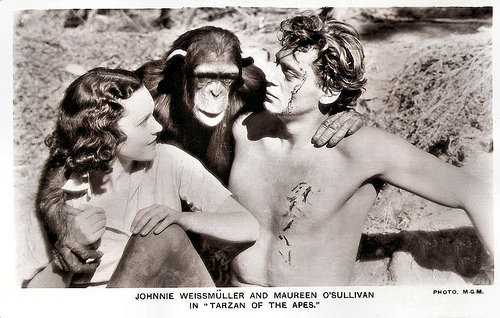
British postcard in the Picturegoer Series, no. 680. Photo: M.G.M. Publicity still for Tarzan the Ape Man (W. S. Van Dyke, 1932) with Maureen O'Sullivan, Cheeta and Johnny Weissmuller.
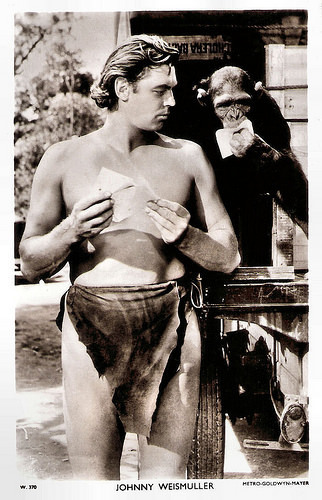
British postcard in the Picturegoer series, London, no. W 370. Photo: Metro-Goldwyn-Mayer.
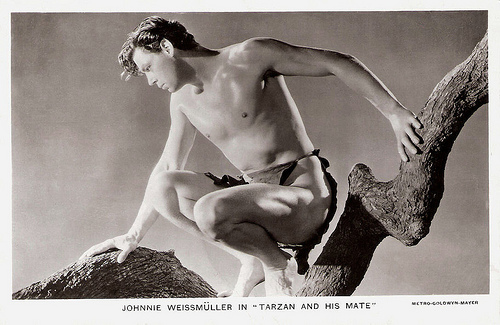
British postcard in the Picturegoer Series, London, no. 864. Photo: Metro-Goldwyn-Mayer. Publicity still for Tarzan and his Mate (W. S. Van Dyke, 1934).
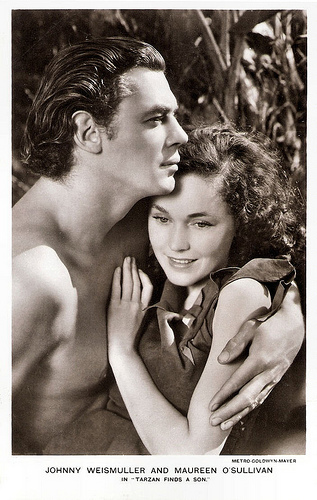
British postcard by Real Photograph, London, no. FS 208. Photo: Metro-Goldwyn-Mayer (MGM). Publicity still for Tarzan Finds A Son (Richard Thorpe, 1939) with Johnny Weissmuller and Maureen O'Sullivan.
An Adonis clad only in a fig leaf
In 1904, Johnny Weissmuller was born as Peter Johann Weißmüller in Freidorf, today Szabadfalva, in the district of the city of Timisoara in Romania, then a part of the Austro-Hungarian Empire. Weissmuller would later claim to have been born in Windber, Pennsylvania, probably to ensure his eligibility to compete as part of the US Olympic team. Weissmüller was one of two boys born to Petrus Weissmuller, a miner, and his wife Elisabeth Kersch, who were both Banat Swabians, an ethnic German population in Southeast Europe. The family arrived in the United States in 1905 when Johnny was 7 months old.
At age nine, young John Weissmüller contracted polio. He took up swimming on the advice of a doctor. After school, he worked as a bellhop and elevator operator at the Plaza Hotel in Chicago and trained for the Olympics with a swim coach at the Illinois Athletic Club. There he developed his revolutionary high-riding front crawl. He made his amateur debut in 1921, winning his first AAU race in the 50-yard freestyle.
From 1921 till 1929 Weismuller won every free style race he entered, from 100 yards to the half-mile. He won 67 world and 52 national titles. At the Olympic Games of 1924 and 1928, he won 5 Gold Medals and broke the record in each race. In 1929, Weissmuller signed a contract with BVD to be a model and representative. He travelled throughout the country doing swim shows, handing out leaflets promoting that brand of swimwear, signing autographs and going on radio. That year he made his film debut in Glorifying the American Girl (John W. Harkrider, Millard Webb, 1929), appearing as an Adonis clad only in a fig leaf in the segment Loveland.
After great success with a jungle movie, MGM head Louis B. Mayer, via Irving Thalberg, optioned two of Edgar Rice Burroughs' Tarzan stories. Cyril Hume, working on the adaptation of Tarzan the Ape Man (W.S. Van Dyke, 1932), noticed Johnny Weissmuller swimming in the pool at his hotel and suggested him for the part of Tarzan. MGM got him released from his BVD contract by agreeing to pose many of its female stars in BVD swimsuits. Weissmuller signed a seven-year contract with Metro-Goldwyn-Mayer
The studio billed him as "the only man in Hollywood who's natural in the flesh and can act without clothes". The film was an immediate box-office and critical hit. And Weissmuller became an overnight international sensation. Seeing that he was wildly popular with girls, the studio told him to divorce his wife and paid her $10,000 to agree to it. Weissmuller starred in six Tarzan movies for MGM with actress Maureen O'Sullivan as Jane and Cheeta the Chimpanzee. The last three also included Johnny Sheffield as Boy.
After 1942, however, MGM had used up its options; it dropped the Tarzan series and Weissmuller, too. He then moved to RKO and made six more Tarzans with markedly reduced production values. Sheffield also appeared as Boy in the first five features for RKO. Brenda Joyce took over the role of Jane in Weissmuller's last four Tarzan movies (the first two RKO films had not featured Jane). Unlike MGM, RKO allowed Weissmuller to play other roles, though a three-picture contract with Pine-Thomas Productions led to only one film, Swamp Fire (William H. Pine, 1946), co-starring Virginia Grey and Buster Crabbe.
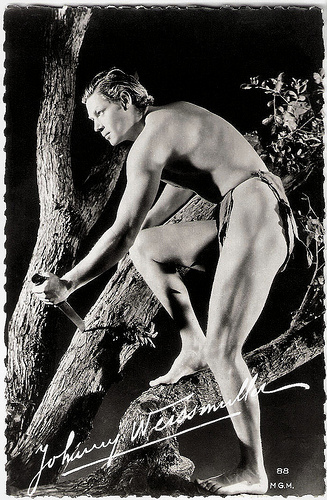
French postcard by Editions en Publications Cinematographiques, no. 88. Photo: Metro-Goldwyn-Mayer.
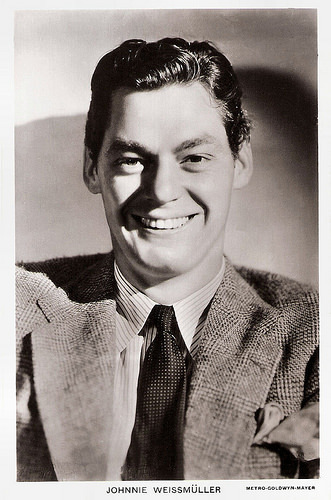
British postcard in the Picturegoer series, London, no. 668b. Photo: Metro-Goldwyn-Mayer.
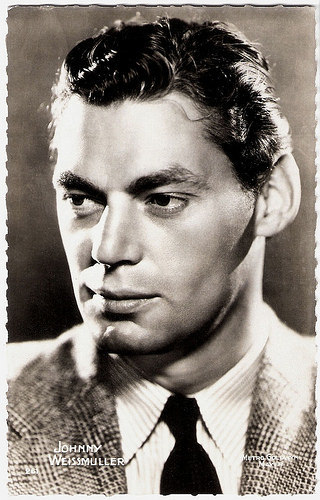
French postcard, no. 261. Photo: Metro-Goldwyn-Mayer (M.G.M).
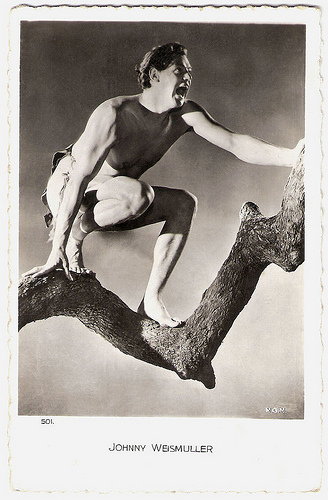
French postcard by Ed. Chantal, Paris no. 501. Photo: M.G.M.
International Swimming Hall of Fame
After his Tarzan career was over, Johnny Weissmuller traded his loincloth costume for a slouch hat and safari suit for the role of Jungle Jim (William Berke, 1948), set in Africa. He made sixteen Jungle Jim films for Columbia between 1948 and 1954. Devil Goddess (Spencer G. Bennet, 1955) was the last entry in the series, as well as being Weissmuller's last feature film.[
In 1955, he began production of the Jungle Jim television adventure series for Screen Gems, a film subsidiary of Columbia. The show produced only twenty-six episodes, which were subsequently played repeatedly on network and syndicated television. Aside from his first screen appearance as Adonis in Glorifying the American Girl (1929) and the role of Johnny Duval in Swamp Fire (1946), Weissmuller played only three roles in films during the heyday of his Hollywood career: Tarzan, Jungle Jim, and himself.
In the late 1950s after retiring from acting, Weissmuller moved back to Chicago and started a swimming pool company. He also lent his name to other business ventures, but did not have a great deal of success. He retired in 1965 and moved to Fort Lauderdale, Florida, where he was Founding Chairman of the International Swimming Hall of Fame.
In 1970, he made a cameo appearance with his former Tarzan co-star Maureen O'Sullivan in the obscure comedy The Phynx (Lee H. Katzin, 1970). In 1973, he moved from Florida to Las Vegas where he was a greeter at the MGM Grand Hotel for a time. In 1974, he broke a hip and leg. While hospitalised he learned that, in spite of his strength and lifelong daily regimen of swimming and exercise, he had a serious heart condition.
In 1976, he appeared for the last time in a film as a crewman who is fired by a movie mogul (Art Carney) in Won Ton Ton, the Dog Who Saved Hollywood (Michael Winner, 1976), and he also made his final public appearance in that year when he was inducted into the Body Building Guild Hall of Fame. In 1984, 'Big John' Weissmuller died in Acapulco, Mexico of pulmonary oedema after a series of strokes. At his request, a recording of his trademark Tarzan yell which he invented was played as his coffin was lowered into the ground.
He married five times and divorced four times. His wives were band and club singer Bobbe Arnst (1931-1933), Mexican film star Lupe Velez (1933-1939), Beryl Scott (1939-1948), Ailene Gates (1948-1962) and Maria Bauman (1963-1984; his death). He had three children with Beryl Scott: actor Johnny Weissmuller Jr. (1940-2006), Wendy Anne (1942), and Heidi Elizabeth (1943-1962).
His daughter Heidi died in a car crash. She had been driving south along the Pacific Coast Highway, on the way to return her husband, and a friend to the naval base in San Diego where they were stationed. A few miles north of Laguna Beach, she fell asleep at the wheel and crashed. Heidi and her unborn child died. Her husband and his friend survived. According to his son, Weissmuller never got over the loss of his daughter and unborn grandchild.
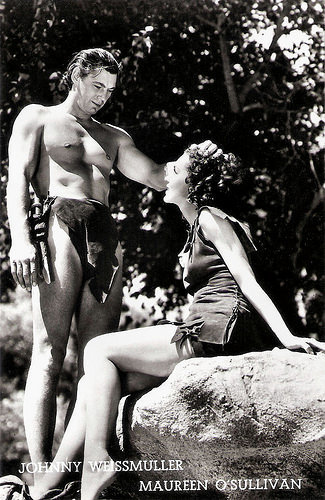
Belgian postcard. Photo: M.G.M. Johnny Weissmuller and Maureen O'Sullivan.
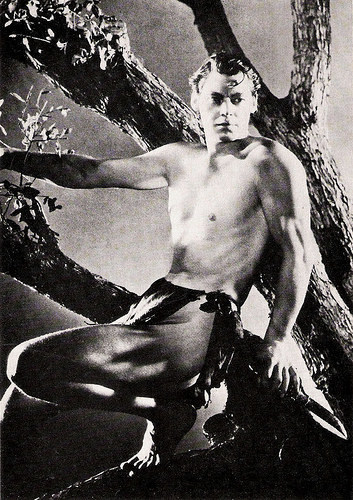
Vintage postcard.
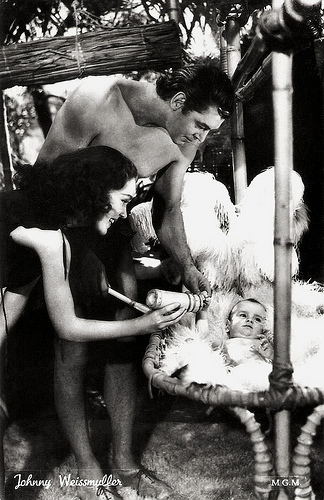
Vintage card. Photo: M.G.M. Publicity still for Tarzan Finds a Son! (Richard Thorpe, 1939) with Johnny Weissmuller and Maureen O'Sullivan.
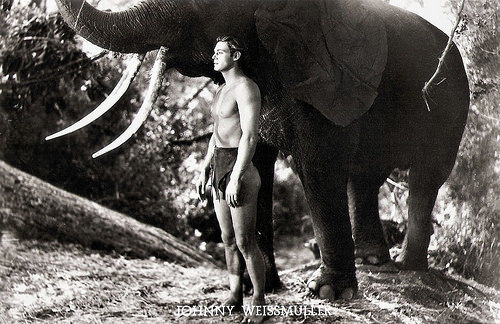
Dutch postcard, no. 751. Photo: M.G.M.
Who did the yell in the Tarzan films?
According to Johnny Weissmuller he did the yell himself and he was inspired by the yodelling of his German neighbours, along with his own success in a yodelling contest he’d won as a boy.
However, MGM claimed to have enhanced the yell in post-production. Reportedly, they added and mixed the following:
1. A second track of Weismuller’s voice, amplified
2. A track of a hyena howl, played backwards
3. A note sung by a female opera soprano, with the speed varied to produce a fluttery sound
4. The growl of a dog
5. The bleat of a camel
6. The raspy note of a violin’s G-string being bowed.
And there are more stories...
Trailer for Tarzan The Ape Man Trailer (1932) - with the yell. Source: Movieclips Trailer Vault (YouTube).
Sources: (IMDb), Mental Floss, Wikipedia and .

British postcard in the Picturegoer Series, no. 680. Photo: M.G.M. Publicity still for Tarzan the Ape Man (W. S. Van Dyke, 1932) with Maureen O'Sullivan, Cheeta and Johnny Weissmuller.

British postcard in the Picturegoer series, London, no. W 370. Photo: Metro-Goldwyn-Mayer.

British postcard in the Picturegoer Series, London, no. 864. Photo: Metro-Goldwyn-Mayer. Publicity still for Tarzan and his Mate (W. S. Van Dyke, 1934).

British postcard by Real Photograph, London, no. FS 208. Photo: Metro-Goldwyn-Mayer (MGM). Publicity still for Tarzan Finds A Son (Richard Thorpe, 1939) with Johnny Weissmuller and Maureen O'Sullivan.
An Adonis clad only in a fig leaf
In 1904, Johnny Weissmuller was born as Peter Johann Weißmüller in Freidorf, today Szabadfalva, in the district of the city of Timisoara in Romania, then a part of the Austro-Hungarian Empire. Weissmuller would later claim to have been born in Windber, Pennsylvania, probably to ensure his eligibility to compete as part of the US Olympic team. Weissmüller was one of two boys born to Petrus Weissmuller, a miner, and his wife Elisabeth Kersch, who were both Banat Swabians, an ethnic German population in Southeast Europe. The family arrived in the United States in 1905 when Johnny was 7 months old.
At age nine, young John Weissmüller contracted polio. He took up swimming on the advice of a doctor. After school, he worked as a bellhop and elevator operator at the Plaza Hotel in Chicago and trained for the Olympics with a swim coach at the Illinois Athletic Club. There he developed his revolutionary high-riding front crawl. He made his amateur debut in 1921, winning his first AAU race in the 50-yard freestyle.
From 1921 till 1929 Weismuller won every free style race he entered, from 100 yards to the half-mile. He won 67 world and 52 national titles. At the Olympic Games of 1924 and 1928, he won 5 Gold Medals and broke the record in each race. In 1929, Weissmuller signed a contract with BVD to be a model and representative. He travelled throughout the country doing swim shows, handing out leaflets promoting that brand of swimwear, signing autographs and going on radio. That year he made his film debut in Glorifying the American Girl (John W. Harkrider, Millard Webb, 1929), appearing as an Adonis clad only in a fig leaf in the segment Loveland.
After great success with a jungle movie, MGM head Louis B. Mayer, via Irving Thalberg, optioned two of Edgar Rice Burroughs' Tarzan stories. Cyril Hume, working on the adaptation of Tarzan the Ape Man (W.S. Van Dyke, 1932), noticed Johnny Weissmuller swimming in the pool at his hotel and suggested him for the part of Tarzan. MGM got him released from his BVD contract by agreeing to pose many of its female stars in BVD swimsuits. Weissmuller signed a seven-year contract with Metro-Goldwyn-Mayer
The studio billed him as "the only man in Hollywood who's natural in the flesh and can act without clothes". The film was an immediate box-office and critical hit. And Weissmuller became an overnight international sensation. Seeing that he was wildly popular with girls, the studio told him to divorce his wife and paid her $10,000 to agree to it. Weissmuller starred in six Tarzan movies for MGM with actress Maureen O'Sullivan as Jane and Cheeta the Chimpanzee. The last three also included Johnny Sheffield as Boy.
After 1942, however, MGM had used up its options; it dropped the Tarzan series and Weissmuller, too. He then moved to RKO and made six more Tarzans with markedly reduced production values. Sheffield also appeared as Boy in the first five features for RKO. Brenda Joyce took over the role of Jane in Weissmuller's last four Tarzan movies (the first two RKO films had not featured Jane). Unlike MGM, RKO allowed Weissmuller to play other roles, though a three-picture contract with Pine-Thomas Productions led to only one film, Swamp Fire (William H. Pine, 1946), co-starring Virginia Grey and Buster Crabbe.

French postcard by Editions en Publications Cinematographiques, no. 88. Photo: Metro-Goldwyn-Mayer.

British postcard in the Picturegoer series, London, no. 668b. Photo: Metro-Goldwyn-Mayer.

French postcard, no. 261. Photo: Metro-Goldwyn-Mayer (M.G.M).

French postcard by Ed. Chantal, Paris no. 501. Photo: M.G.M.
International Swimming Hall of Fame
After his Tarzan career was over, Johnny Weissmuller traded his loincloth costume for a slouch hat and safari suit for the role of Jungle Jim (William Berke, 1948), set in Africa. He made sixteen Jungle Jim films for Columbia between 1948 and 1954. Devil Goddess (Spencer G. Bennet, 1955) was the last entry in the series, as well as being Weissmuller's last feature film.[
In 1955, he began production of the Jungle Jim television adventure series for Screen Gems, a film subsidiary of Columbia. The show produced only twenty-six episodes, which were subsequently played repeatedly on network and syndicated television. Aside from his first screen appearance as Adonis in Glorifying the American Girl (1929) and the role of Johnny Duval in Swamp Fire (1946), Weissmuller played only three roles in films during the heyday of his Hollywood career: Tarzan, Jungle Jim, and himself.
In the late 1950s after retiring from acting, Weissmuller moved back to Chicago and started a swimming pool company. He also lent his name to other business ventures, but did not have a great deal of success. He retired in 1965 and moved to Fort Lauderdale, Florida, where he was Founding Chairman of the International Swimming Hall of Fame.
In 1970, he made a cameo appearance with his former Tarzan co-star Maureen O'Sullivan in the obscure comedy The Phynx (Lee H. Katzin, 1970). In 1973, he moved from Florida to Las Vegas where he was a greeter at the MGM Grand Hotel for a time. In 1974, he broke a hip and leg. While hospitalised he learned that, in spite of his strength and lifelong daily regimen of swimming and exercise, he had a serious heart condition.
In 1976, he appeared for the last time in a film as a crewman who is fired by a movie mogul (Art Carney) in Won Ton Ton, the Dog Who Saved Hollywood (Michael Winner, 1976), and he also made his final public appearance in that year when he was inducted into the Body Building Guild Hall of Fame. In 1984, 'Big John' Weissmuller died in Acapulco, Mexico of pulmonary oedema after a series of strokes. At his request, a recording of his trademark Tarzan yell which he invented was played as his coffin was lowered into the ground.
He married five times and divorced four times. His wives were band and club singer Bobbe Arnst (1931-1933), Mexican film star Lupe Velez (1933-1939), Beryl Scott (1939-1948), Ailene Gates (1948-1962) and Maria Bauman (1963-1984; his death). He had three children with Beryl Scott: actor Johnny Weissmuller Jr. (1940-2006), Wendy Anne (1942), and Heidi Elizabeth (1943-1962).
His daughter Heidi died in a car crash. She had been driving south along the Pacific Coast Highway, on the way to return her husband, and a friend to the naval base in San Diego where they were stationed. A few miles north of Laguna Beach, she fell asleep at the wheel and crashed. Heidi and her unborn child died. Her husband and his friend survived. According to his son, Weissmuller never got over the loss of his daughter and unborn grandchild.

Belgian postcard. Photo: M.G.M. Johnny Weissmuller and Maureen O'Sullivan.

Vintage postcard.

Vintage card. Photo: M.G.M. Publicity still for Tarzan Finds a Son! (Richard Thorpe, 1939) with Johnny Weissmuller and Maureen O'Sullivan.

Dutch postcard, no. 751. Photo: M.G.M.
Who did the yell in the Tarzan films?
According to Johnny Weissmuller he did the yell himself and he was inspired by the yodelling of his German neighbours, along with his own success in a yodelling contest he’d won as a boy.
However, MGM claimed to have enhanced the yell in post-production. Reportedly, they added and mixed the following:
1. A second track of Weismuller’s voice, amplified
2. A track of a hyena howl, played backwards
3. A note sung by a female opera soprano, with the speed varied to produce a fluttery sound
4. The growl of a dog
5. The bleat of a camel
6. The raspy note of a violin’s G-string being bowed.
And there are more stories...
Trailer for Tarzan The Ape Man Trailer (1932) - with the yell. Source: Movieclips Trailer Vault (YouTube).
Sources: (IMDb), Mental Floss, Wikipedia and .
Published on April 29, 2017 22:00
April 28, 2017
Marcel Cerdan
World boxing champion Marcel Cerdan (1916–1949) was France's greatest boxer with the nickname ‘The Casablanca Clouter’. His life was marked by his sporting achievements, his passionate love affair with Édith Piaf and his tragical death. He appeared in two films and was portrayed in two films.
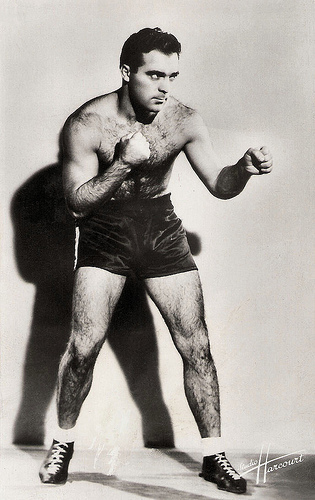
French postcard by Edition O.P., Paris, no. 23. Photo: Studio Harcourt.
World Champion
Marcellin ‘Marcel’ Cerdan was born in Sidi Bel Abbès in what was then French Algeria in 1916.
He began boxing professionally in 1934 in Meknes, Morocco, beating Marcel Bucchianeri by a decision in six rounds. Cerdan then ran a streak of 47 wins in a row between that first bout and 1939, when he lost for the first time, to Harry Craster by a disqualification in five rounds in London.
Cerdan campaigned heavily in the French territories of Algeria and Morocco during that part of his career, as well as in metropolitan France, his parents' place of birth. In 1938, he beat Omar Kouidri in a 12-round decision at Casablanca to claim the French welterweight title.
After his first loss, Cerdan recorded five consecutive wins, which led him to challenge Saviello Turiello for Europe's welterweight title in Milan, Italy. He won the European title by a decision in 15 rounds to continue his ascent towards the championship. Cerdan's winning streak eventually reached 23 bouts before he suffered a defeat to Victor Buttin by disqualification in eight rounds in Algiers.
In 1944 he joined the American allies in World War II, and he won the Inter-Allied Championship. He also went up in weight to the Middleweight division, and won the French title by beating Assane Douf by a knockout in three rounds. He later claimed the vacant European title by beating Léon Foquet by a knockout in one round. He retained that title a couple of times before losing it to Cyrille Delannoit by a decision in 15 at Brussels, Belgium.
Soon, he went back to Belgium and re-took the title by beating Delannoit, also by decision. Finally, after the rematch with Delannoit, Cerdan was given a world title opportunity and he travelled to the United States, where he beat world Middleweight champion Tony Zale. Cerdan became a world champion by knocking Zale out in the 12th round in Roosevelt Stadium, New Jersey in 1948.
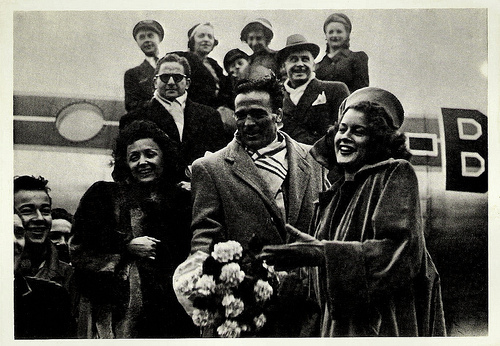
French postcard by Editions Gendre, Paris, no. 27. Photo: Keystone. Caption: Edith Piaf, Marcel Cerdan, March 1948.
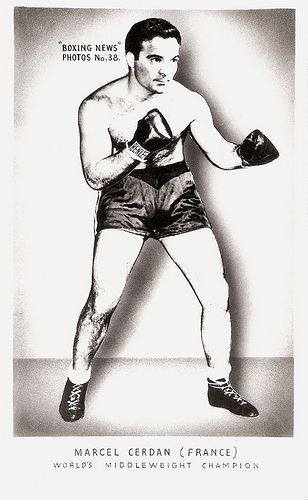
American postcard. Photo: Boxing News, no. 38.
Piaf
During his short period as a world champion, Marcel Cerdan became a popular figure of the Paris scene. Although married with three children, he had an affair with the famous singer Édith Piaf . The affair lasted from summer 1948 until his death in autumn 1949. They were very devoted to each other and Piaf wrote one of her most famous songs, Hymne à l'amour, for Cerdan.
He also appeared in two films. He was himself in the French film L'homme aux mains d'argile/The man with the hands of clay (Léon Mathot, 1949) with Blanchette Brunoy , and he played a boxer in the Italian comedy Al diavolo la celebrità/A Night of Fame (Mario Monicelli, Steno, 1951) with Mischa Auer.
For his first defense Cerdan returned to the United States, where he fought Jake LaMotta in Detroit. Cerdan was knocked down in round one, his shoulder was dislocated, and he had to give up after the tenth round. It would be the last fight of Cerdan's life.
A contract was signed for a rematch and Cerdan went to training camp for it, but before camp began he boarded an Air France flight to visit Piaf in New York, where she was singing. The Lockheed L-749 Constellation crashed into Pico da Vara (São Miguel Island, Azores), killing all 11 crew members and 37 passengers on board, including Cerdan and the famous French violinist Ginette Neveu, while approaching the intermediate stop airport at Santa Maria. Cerdan was only 33.
Marcel Cerdan's record was 113 wins and 4 losses, with 66 wins by knockout. In 1983, Cerdan and Piaf had their lives turned into a big screen biography. The film, Édith et Marcel (Claude Lelouch, 1983), starred Marcel Cerdan, Jr. in the role of his father and Évelyne Bouix as Piaf. In 2007 he was portrayed by Jean-Pierre Martins in La Môme/La Vie en Rose (Olivier Dahan, 2007).
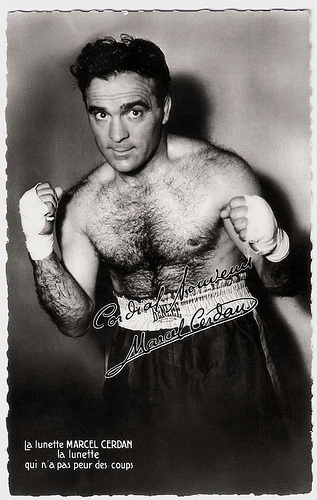
French promotion card for La lunette Marcel Cerdan. Caption: La lunette Marcel Cerdan, la lunette qui ná pas peur des coups. (The Marcel Cerdan bezel, the bezel who is not afraid of blows).
Sources: Wikipedia and .

French postcard by Edition O.P., Paris, no. 23. Photo: Studio Harcourt.
World Champion
Marcellin ‘Marcel’ Cerdan was born in Sidi Bel Abbès in what was then French Algeria in 1916.
He began boxing professionally in 1934 in Meknes, Morocco, beating Marcel Bucchianeri by a decision in six rounds. Cerdan then ran a streak of 47 wins in a row between that first bout and 1939, when he lost for the first time, to Harry Craster by a disqualification in five rounds in London.
Cerdan campaigned heavily in the French territories of Algeria and Morocco during that part of his career, as well as in metropolitan France, his parents' place of birth. In 1938, he beat Omar Kouidri in a 12-round decision at Casablanca to claim the French welterweight title.
After his first loss, Cerdan recorded five consecutive wins, which led him to challenge Saviello Turiello for Europe's welterweight title in Milan, Italy. He won the European title by a decision in 15 rounds to continue his ascent towards the championship. Cerdan's winning streak eventually reached 23 bouts before he suffered a defeat to Victor Buttin by disqualification in eight rounds in Algiers.
In 1944 he joined the American allies in World War II, and he won the Inter-Allied Championship. He also went up in weight to the Middleweight division, and won the French title by beating Assane Douf by a knockout in three rounds. He later claimed the vacant European title by beating Léon Foquet by a knockout in one round. He retained that title a couple of times before losing it to Cyrille Delannoit by a decision in 15 at Brussels, Belgium.
Soon, he went back to Belgium and re-took the title by beating Delannoit, also by decision. Finally, after the rematch with Delannoit, Cerdan was given a world title opportunity and he travelled to the United States, where he beat world Middleweight champion Tony Zale. Cerdan became a world champion by knocking Zale out in the 12th round in Roosevelt Stadium, New Jersey in 1948.

French postcard by Editions Gendre, Paris, no. 27. Photo: Keystone. Caption: Edith Piaf, Marcel Cerdan, March 1948.

American postcard. Photo: Boxing News, no. 38.
Piaf
During his short period as a world champion, Marcel Cerdan became a popular figure of the Paris scene. Although married with three children, he had an affair with the famous singer Édith Piaf . The affair lasted from summer 1948 until his death in autumn 1949. They were very devoted to each other and Piaf wrote one of her most famous songs, Hymne à l'amour, for Cerdan.
He also appeared in two films. He was himself in the French film L'homme aux mains d'argile/The man with the hands of clay (Léon Mathot, 1949) with Blanchette Brunoy , and he played a boxer in the Italian comedy Al diavolo la celebrità/A Night of Fame (Mario Monicelli, Steno, 1951) with Mischa Auer.
For his first defense Cerdan returned to the United States, where he fought Jake LaMotta in Detroit. Cerdan was knocked down in round one, his shoulder was dislocated, and he had to give up after the tenth round. It would be the last fight of Cerdan's life.
A contract was signed for a rematch and Cerdan went to training camp for it, but before camp began he boarded an Air France flight to visit Piaf in New York, where she was singing. The Lockheed L-749 Constellation crashed into Pico da Vara (São Miguel Island, Azores), killing all 11 crew members and 37 passengers on board, including Cerdan and the famous French violinist Ginette Neveu, while approaching the intermediate stop airport at Santa Maria. Cerdan was only 33.
Marcel Cerdan's record was 113 wins and 4 losses, with 66 wins by knockout. In 1983, Cerdan and Piaf had their lives turned into a big screen biography. The film, Édith et Marcel (Claude Lelouch, 1983), starred Marcel Cerdan, Jr. in the role of his father and Évelyne Bouix as Piaf. In 2007 he was portrayed by Jean-Pierre Martins in La Môme/La Vie en Rose (Olivier Dahan, 2007).

French promotion card for La lunette Marcel Cerdan. Caption: La lunette Marcel Cerdan, la lunette qui ná pas peur des coups. (The Marcel Cerdan bezel, the bezel who is not afraid of blows).
Sources: Wikipedia and .
Published on April 28, 2017 22:00
April 27, 2017
Horst Frank
German film actor Horst Frank (1929–1999) appeared in more than 100 films between 1955 and 1999. During the 1960s he was the blond, steely-eyed bad guy of of countless Spaghetti Westerns and Eurospy films.
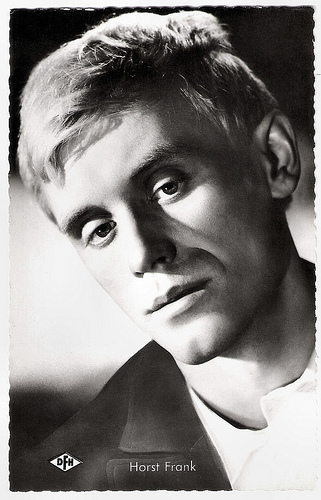
German postcard by Kolibri-Verlag G.m.b.H., Minden/Westf., no. 192. Photo: DFH. Publicity still for Der Greifer/The Copper (Eugen York, 1958).
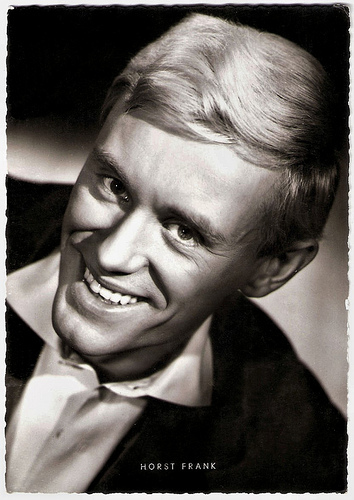
German postcard by IRMA-Verlag, Stuttgart-W, no. 1523. Photo; Kurt Ulrich Film / DFH / Wesel. Publicity still for Der Greifer/The Copper (Eugen York, 1958).
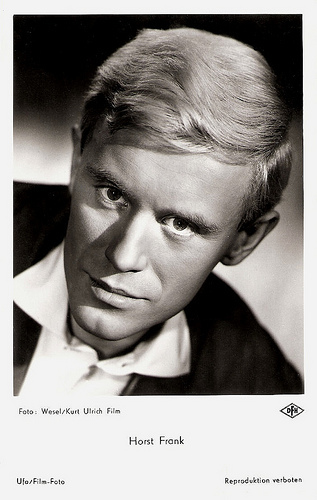
German postcard by Ufa, Berlin-Tempelhof, no. FK 3991. Photo: Wesel / Kurt Ulrich Film / DFH. Publicity still for Der Greifer/The Copper (Eugen York, 1958).
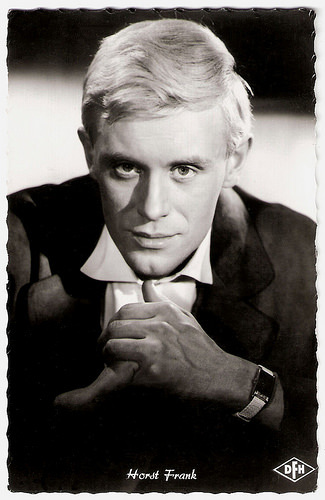
German postcard by Kolibri-Verlag, Minden/Westf., no. 135. Photo: Kurt Ulrich Film / DFH / Wesel. Publicity still for Der Greifer/The Copper (Eugen York, 1958).
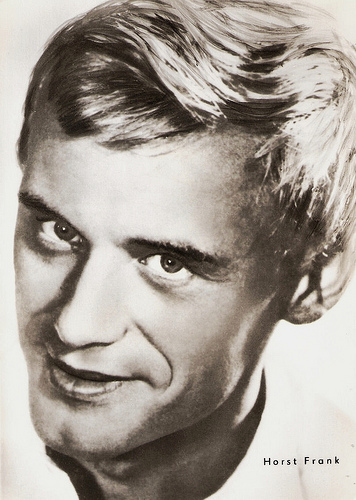
East-German postcard by VEB Progress Film-Vertrieb, Berlin, no. 192/71. Photo: Steffen.
A somewhat cold, hypnotic gaze
Horst Bernhard Wilhelm Frank was born in 1929 in Lübeck, Germany, the son of a porcelain painter. After graduation, he completed an apprenticeship as a trader. He then enrolled in the acting class at the Musikhochschule Hamburg (Music Academy Hamburg) but failed his final exams. Nonetheless he managed to secure an acting position in his hometown. For some time after, his work was primarily confined to small parts on stage and in radio.
In Baden-Baden, he became a member of the Südwestfunk ensemble and started working for television. He made his film debut as a cynical, cowardly pilot in the West-German war film Der Stern von Afrika/The Star of Africa (Alfred Weidenmann, 1957), portraying the combat career of a World War II Luftwaffe fighter pilot Hans-Joachim Marseille ( Joachim Hansen ). The film was successful at the German box office.
Frank then won a critic's award for his next role as member of a U-Boat crew in the war drama Haie und kleine Fische/Sharks and Little Fish (Frank Wisbar, 1957). Next he played supporting parts in such West-German productions as the crime film Der Greifer/The Copper (Eugen York, 1958) starring Hans Albers , Das Mädchen Rosemarie/Rosemary (Rolf Thiele, 1958) featuring Nadja Tiller , and the war film Hunde, wollt ihr ewig leben/Dogs, Do You Want to Live Forever (Frank Wisbar, 1959).
I.S. Mowis at IMDb : “Of athletic, lithe build and owner of a somewhat cold, hypnotic gaze (with a voice to match), Frank soon found himself typecast to disturbingly good effect as psychotic murderers in German and international productions”. In Italy, he appeared with Massimo Girotti in the drama Lupi nell'abisso/Wolves of the Deep (Silvio Amadio, 1959), and in France with Françoise Arnoul in the war drama La chatte sort ses griffes/The Cat Shows Her Claws (Henri Decoin, 1960) and with Laurent Terzieff in Tu ne tueras point/Thou Shalt Not Kill (Claude Autant-Lara, 1961).
From 1961 to 1963 he lived in Tanganyika on his own farm and raised coffee and vegetables. Political turmoil forced him to return to Germany. Frank appeared in several pan-European productions, such as the French-Italian-German crime comedy Les Tontons flingueurs/Crooks in Clover (Georges Lautner, 1963) with Lino Ventura , and the German-French-Italian Eurowestern Die Flußpiraten vom Mississippi/The Pirates of the Mississippi (Jürgen Roland, 1963) starring Hansjörg Felmy and Brad Harris .
He was also in the German-French-Italian spy film Die Diamantenholle am Mekong/Mission to Hell (Gianfranco Parolini, 1964) starring Paul Hubschmid . It was one of the first Eurospy productions and a box office hit. In Italy, he proved to be an ideal henchman in the Spaghetti Western Le pistole non discutono/Bullets Don't Argue (Mario Caiano, 1964). The film was produced by Jolly Film back to back with Sergio Leone's Per un pugno di dollari/A Fistful of Dollars (1964), but with a more expensive budget. The producer expected a greater success than Leone's film, especially because at the time lead actor Rod Cameron was better known than Clint Eastwood .
Frank appeared in several other Eurowesterns and Eurospy films. Most of them are mediocre, but interesting is the Spaghetti Western Preparati la bara!/Django, Prepare a Coffin (Ferdinando Baldi, 1968) with Terence Hill in the title role. Django was previously played by Franco Nero in Sergio Corbucci's original Django (1966). Django, Prepare a Coffin is unique among the plethora of films which capitalised on Corbucci's hit in that it is not only a semi-official, legitimate follow-up, but was also originally meant to star Franco Nero . Curious is also Quella sporca storia nel West/Johnny Hamlet (Enzo G. Castellari, 1968), a Spaghetti Western version of William Shakespeare's Hamlet.
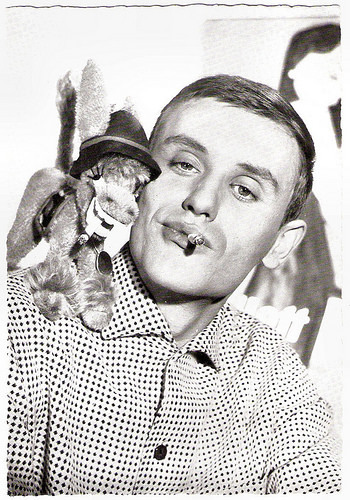
German postcard by WS-Druck, Wanne-Eickel, no. 372.
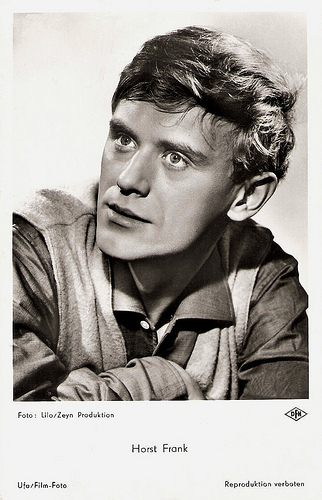
German postcard by Ufa, Berlin-Tempelhof, no. FK 3781. Photo: Lilo / Zeyn Produktion / DFH. Publicity still for Haie und kleine Fische/Sharks and Little Fish (Frank Wisbar, 1957).
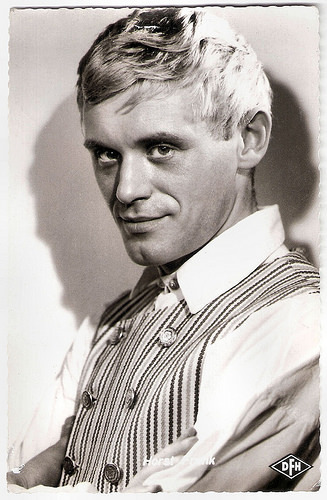
German postcard by Kolibri-Verlag G.m.b.H., Minden/Westf., no. 346. Photo: Real / DFH / Lilo. Publicity still for Das Mädchen vom Moorhof (Gustav Ucicky, 1958).
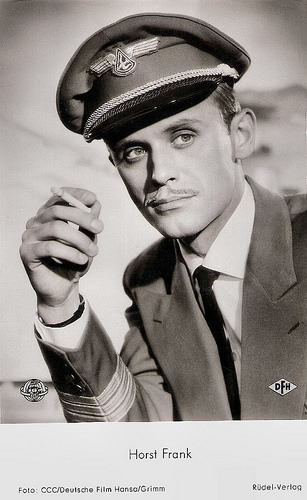
German postcard by Rüdel-Verlag, Hamburg-Bergedorff, no. 2866. Photo: CCC / Deutsche Film Hansa / Grimm. Publicity still for Abschied von den Wolken/Rebel Flight to Cuba (Gottfried Reinhardt, 1959).
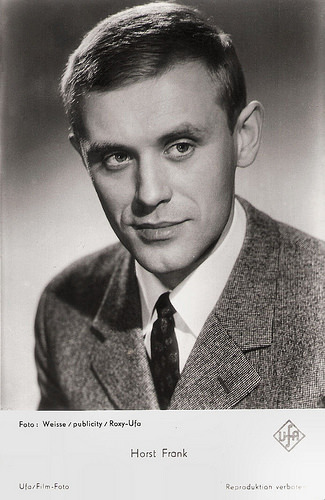
Austrian postcard by HDH-Verlag (Hubmann), Wien, no. 346. Photo: Weisse-Publicity / Roxy / Ufa. Publicity still for Bumerang/Cry Double Cross (Alfred Weidenmann, 1960).
Ruthless killers and impassive assassins
During the 1970s, Horst Frank often played of ruthless killers and impassive assassins in Italian genre films, including the Giallo Il gatto a nove ode/The Cat o' Nine Tails (Dario Argento, 1971). This is the middle entry in Argento's so-called Animal Trilogy along with L'uccello dalle piume di cristallo/The Bird with the Crystal Plumage (1970) and 4 mosche di velluto grigio/Four Flies on Grey Velvet (1972).
Frank also worked regularly in Germany. An example is the television film Carlos (1971) for which director Hans W. Geissendorfer transplanted the story of Friedrich Schiller's play Don Carlos from 16th century Spain to a 1915 American Western style environment.
From 1973 on, Frank frequently worked in the theatre, touring with his own productions of plays by Noel Coward and Peter Ustinov, and often worked for German television. He guest-starred in several episodes of the popular Krimi series Der Kommissar, Tatort and Derrick, and also starred in the miniseries Timm Thaler/The Legend of Tim Tyler: The Boy Who Lost His Laugh (Sigi Rothemund, 1979).
Incidentally he appeared in interesting films such as the Science-Fiction film Operation Ganymed (Rainer Erler, 1977) about a spaceship which returns to Earth after several years of space exploration and finds it desolate. Another highlight was the TV film Wege in der Nacht/Ways in the Night (Krzysztof Zanussi, 1979) with Mathieu Carrière.
In addition to his screen acting, Frank lent his voice to dubbing work for fellow tough guys like Jack Palance, Ernest Borgnine and Chuck Connors. On the radio, he voiced Captain Nemo in 20,000 Leagues Under the Sea and The Mysterious Island. I.S. Mowis: “Behind the menacing heavy, there was a family man and author of poems and chansons. (…) Likely because of his lack of work in major American or British productions, Frank never quite achieved the international recognition he undoubtedly deserved.”
Among his last screen credits were the romanticised TV biography Catherine the Great (Marvin J. Chomsky, John Goldsmith, 1996) with Catherine Zeta-Jones as Empress Catherine II, and Die Menschen sind kalt/People are cold (Andreas Dorau, 1998). In 1999, Horst Frank quite suddenly died of a brain hemorrhage, just short of his 70th birthday. He had a son from his first marriage and a daughter named Désirée from his second marriage to actress Chariklia Baxevanos. From 1979 till his death, he was married to actress Brigitte Kollecker.
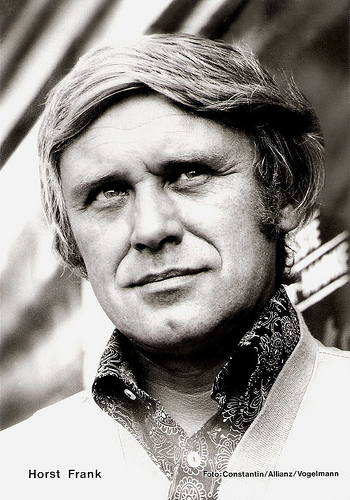
German postcard by Rüdel-Verlag, Hamburg. Photo: Constantin / Allianz / Vogelmann. Publicity still for Fluchtweg St. Pauli - Großalarm für die Davidswache/Hot Traces of St. Pauli (Wolfgang Staudte, 1971).
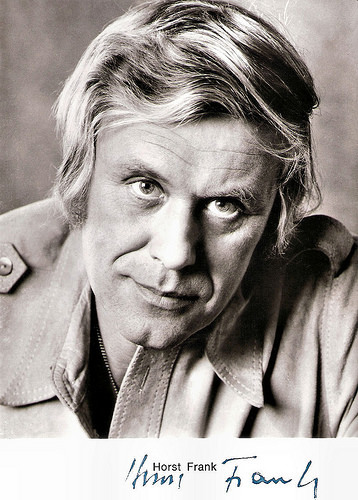
German postcard by Franz Josef Rüdel, Filmpostkartenverlag, Hamburg. Photo: Sessner, Dachau.
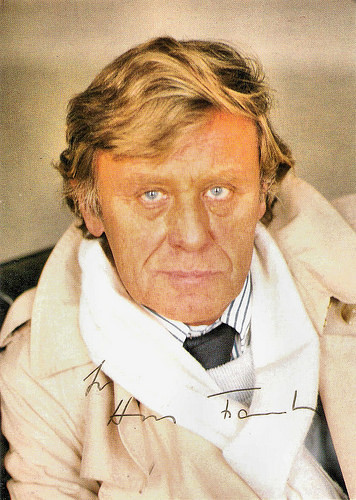
German autograph card by Büro für promotion, Bielefeld.
German trailer for Preparati la bara!/Django, Prepare a Coffin (1968). Source: Spaghetti Western Database (YouTube).
German trailer for Fluchtweg St. Pauli - Großalarm für die Davidswache/Hot Traces of St. Pauli (1971). Source: Italo-Cinema Trailer (YouTube).
Sources: (IMDb), Filmportal.de, Wikipedia (German and English) and .

German postcard by Kolibri-Verlag G.m.b.H., Minden/Westf., no. 192. Photo: DFH. Publicity still for Der Greifer/The Copper (Eugen York, 1958).

German postcard by IRMA-Verlag, Stuttgart-W, no. 1523. Photo; Kurt Ulrich Film / DFH / Wesel. Publicity still for Der Greifer/The Copper (Eugen York, 1958).

German postcard by Ufa, Berlin-Tempelhof, no. FK 3991. Photo: Wesel / Kurt Ulrich Film / DFH. Publicity still for Der Greifer/The Copper (Eugen York, 1958).

German postcard by Kolibri-Verlag, Minden/Westf., no. 135. Photo: Kurt Ulrich Film / DFH / Wesel. Publicity still for Der Greifer/The Copper (Eugen York, 1958).

East-German postcard by VEB Progress Film-Vertrieb, Berlin, no. 192/71. Photo: Steffen.
A somewhat cold, hypnotic gaze
Horst Bernhard Wilhelm Frank was born in 1929 in Lübeck, Germany, the son of a porcelain painter. After graduation, he completed an apprenticeship as a trader. He then enrolled in the acting class at the Musikhochschule Hamburg (Music Academy Hamburg) but failed his final exams. Nonetheless he managed to secure an acting position in his hometown. For some time after, his work was primarily confined to small parts on stage and in radio.
In Baden-Baden, he became a member of the Südwestfunk ensemble and started working for television. He made his film debut as a cynical, cowardly pilot in the West-German war film Der Stern von Afrika/The Star of Africa (Alfred Weidenmann, 1957), portraying the combat career of a World War II Luftwaffe fighter pilot Hans-Joachim Marseille ( Joachim Hansen ). The film was successful at the German box office.
Frank then won a critic's award for his next role as member of a U-Boat crew in the war drama Haie und kleine Fische/Sharks and Little Fish (Frank Wisbar, 1957). Next he played supporting parts in such West-German productions as the crime film Der Greifer/The Copper (Eugen York, 1958) starring Hans Albers , Das Mädchen Rosemarie/Rosemary (Rolf Thiele, 1958) featuring Nadja Tiller , and the war film Hunde, wollt ihr ewig leben/Dogs, Do You Want to Live Forever (Frank Wisbar, 1959).
I.S. Mowis at IMDb : “Of athletic, lithe build and owner of a somewhat cold, hypnotic gaze (with a voice to match), Frank soon found himself typecast to disturbingly good effect as psychotic murderers in German and international productions”. In Italy, he appeared with Massimo Girotti in the drama Lupi nell'abisso/Wolves of the Deep (Silvio Amadio, 1959), and in France with Françoise Arnoul in the war drama La chatte sort ses griffes/The Cat Shows Her Claws (Henri Decoin, 1960) and with Laurent Terzieff in Tu ne tueras point/Thou Shalt Not Kill (Claude Autant-Lara, 1961).
From 1961 to 1963 he lived in Tanganyika on his own farm and raised coffee and vegetables. Political turmoil forced him to return to Germany. Frank appeared in several pan-European productions, such as the French-Italian-German crime comedy Les Tontons flingueurs/Crooks in Clover (Georges Lautner, 1963) with Lino Ventura , and the German-French-Italian Eurowestern Die Flußpiraten vom Mississippi/The Pirates of the Mississippi (Jürgen Roland, 1963) starring Hansjörg Felmy and Brad Harris .
He was also in the German-French-Italian spy film Die Diamantenholle am Mekong/Mission to Hell (Gianfranco Parolini, 1964) starring Paul Hubschmid . It was one of the first Eurospy productions and a box office hit. In Italy, he proved to be an ideal henchman in the Spaghetti Western Le pistole non discutono/Bullets Don't Argue (Mario Caiano, 1964). The film was produced by Jolly Film back to back with Sergio Leone's Per un pugno di dollari/A Fistful of Dollars (1964), but with a more expensive budget. The producer expected a greater success than Leone's film, especially because at the time lead actor Rod Cameron was better known than Clint Eastwood .
Frank appeared in several other Eurowesterns and Eurospy films. Most of them are mediocre, but interesting is the Spaghetti Western Preparati la bara!/Django, Prepare a Coffin (Ferdinando Baldi, 1968) with Terence Hill in the title role. Django was previously played by Franco Nero in Sergio Corbucci's original Django (1966). Django, Prepare a Coffin is unique among the plethora of films which capitalised on Corbucci's hit in that it is not only a semi-official, legitimate follow-up, but was also originally meant to star Franco Nero . Curious is also Quella sporca storia nel West/Johnny Hamlet (Enzo G. Castellari, 1968), a Spaghetti Western version of William Shakespeare's Hamlet.

German postcard by WS-Druck, Wanne-Eickel, no. 372.

German postcard by Ufa, Berlin-Tempelhof, no. FK 3781. Photo: Lilo / Zeyn Produktion / DFH. Publicity still for Haie und kleine Fische/Sharks and Little Fish (Frank Wisbar, 1957).

German postcard by Kolibri-Verlag G.m.b.H., Minden/Westf., no. 346. Photo: Real / DFH / Lilo. Publicity still for Das Mädchen vom Moorhof (Gustav Ucicky, 1958).

German postcard by Rüdel-Verlag, Hamburg-Bergedorff, no. 2866. Photo: CCC / Deutsche Film Hansa / Grimm. Publicity still for Abschied von den Wolken/Rebel Flight to Cuba (Gottfried Reinhardt, 1959).

Austrian postcard by HDH-Verlag (Hubmann), Wien, no. 346. Photo: Weisse-Publicity / Roxy / Ufa. Publicity still for Bumerang/Cry Double Cross (Alfred Weidenmann, 1960).
Ruthless killers and impassive assassins
During the 1970s, Horst Frank often played of ruthless killers and impassive assassins in Italian genre films, including the Giallo Il gatto a nove ode/The Cat o' Nine Tails (Dario Argento, 1971). This is the middle entry in Argento's so-called Animal Trilogy along with L'uccello dalle piume di cristallo/The Bird with the Crystal Plumage (1970) and 4 mosche di velluto grigio/Four Flies on Grey Velvet (1972).
Frank also worked regularly in Germany. An example is the television film Carlos (1971) for which director Hans W. Geissendorfer transplanted the story of Friedrich Schiller's play Don Carlos from 16th century Spain to a 1915 American Western style environment.
From 1973 on, Frank frequently worked in the theatre, touring with his own productions of plays by Noel Coward and Peter Ustinov, and often worked for German television. He guest-starred in several episodes of the popular Krimi series Der Kommissar, Tatort and Derrick, and also starred in the miniseries Timm Thaler/The Legend of Tim Tyler: The Boy Who Lost His Laugh (Sigi Rothemund, 1979).
Incidentally he appeared in interesting films such as the Science-Fiction film Operation Ganymed (Rainer Erler, 1977) about a spaceship which returns to Earth after several years of space exploration and finds it desolate. Another highlight was the TV film Wege in der Nacht/Ways in the Night (Krzysztof Zanussi, 1979) with Mathieu Carrière.
In addition to his screen acting, Frank lent his voice to dubbing work for fellow tough guys like Jack Palance, Ernest Borgnine and Chuck Connors. On the radio, he voiced Captain Nemo in 20,000 Leagues Under the Sea and The Mysterious Island. I.S. Mowis: “Behind the menacing heavy, there was a family man and author of poems and chansons. (…) Likely because of his lack of work in major American or British productions, Frank never quite achieved the international recognition he undoubtedly deserved.”
Among his last screen credits were the romanticised TV biography Catherine the Great (Marvin J. Chomsky, John Goldsmith, 1996) with Catherine Zeta-Jones as Empress Catherine II, and Die Menschen sind kalt/People are cold (Andreas Dorau, 1998). In 1999, Horst Frank quite suddenly died of a brain hemorrhage, just short of his 70th birthday. He had a son from his first marriage and a daughter named Désirée from his second marriage to actress Chariklia Baxevanos. From 1979 till his death, he was married to actress Brigitte Kollecker.

German postcard by Rüdel-Verlag, Hamburg. Photo: Constantin / Allianz / Vogelmann. Publicity still for Fluchtweg St. Pauli - Großalarm für die Davidswache/Hot Traces of St. Pauli (Wolfgang Staudte, 1971).

German postcard by Franz Josef Rüdel, Filmpostkartenverlag, Hamburg. Photo: Sessner, Dachau.

German autograph card by Büro für promotion, Bielefeld.
German trailer for Preparati la bara!/Django, Prepare a Coffin (1968). Source: Spaghetti Western Database (YouTube).
German trailer for Fluchtweg St. Pauli - Großalarm für die Davidswache/Hot Traces of St. Pauli (1971). Source: Italo-Cinema Trailer (YouTube).
Sources: (IMDb), Filmportal.de, Wikipedia (German and English) and .
Published on April 27, 2017 22:00
April 26, 2017
Winnetou II. Teil (1964)
The German Westerm Winnetou – 2. Teil/Last of the Renegades (Harald Reinl, 1964), also known as Winnetou: The Red Gentleman, is one of the Eurowesterns in the series based on the novels by Karl May. Stars are Pierre Brice as Apache chief Winnetou and Lex Barker as his soul mate Old Shatterhand.
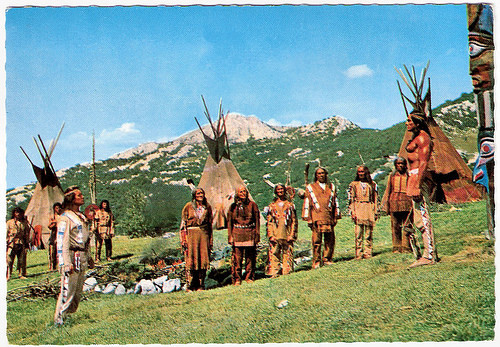
German postcard, no. R 5. Photo: publicity still of Pierre Brice and Gojko Mitic in Winnetou II. Teil/Winnetou: The Red Gentleman (Harald Reinl, 1964). Caption: "Winnetou hat die Assiniboins für seine Pläne gewonnen, und man beschliesst eine Verhandlung mit den Weissen in Fort Niobara. Botschaft hierüber geht an alle Häuptlinge." (Winnetou has won the Assiniboins for his plans, and they choose for a negotiation with the white in Fort Niobara. This message goes to all chiefs.)
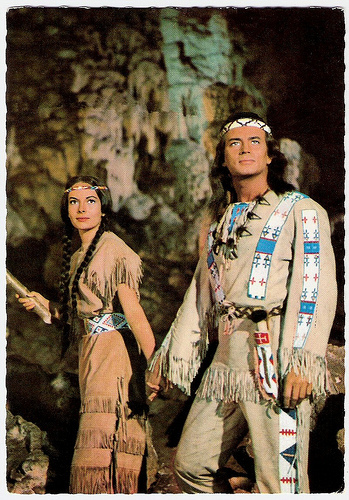
German postcard, no. R 7. Photo: still from Winnetou II. Teil/Last of the Renegades (Harald Reinl, 1964) with Karin Dor as Ribanna and Pierre Brice as Winnetou. Caption: "Ribanna lüftet ein Geheimnis. Sie zeigt Winnetou eine im Felsen verborgene Höhle, die in Kriegszeiten den Frauen und Kinder als Zuflkuchtsstätte dient." (Ribanna reveals a secret. She shows Winnetou a cave hidden in the rock, which in wartime serves the women and children as a refuge.)
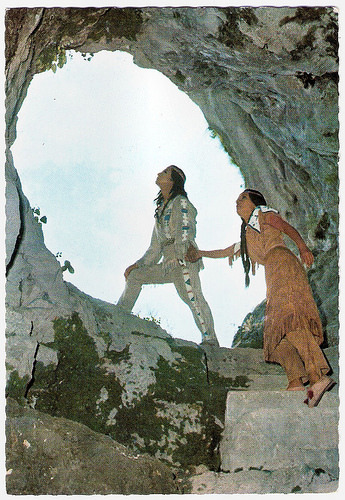
German postcard, no R 8. Photo: publicity still for Winnetou II. Teil/Winnetou: The Red Gentleman (Harald Reinl, 1964) with Pierre Brice and Karin Dor . Caption: "Noch ahnt man nicht, wie bald von diesem Versteck Gebrauch gemacht werden muss; den Forrester, der sein dunkles Gerwerbe auf Kosten der Indianer betreibt, schmiedet schon Pläne." (Yet nobody suspects how soon this hiding place must be used; Forrester, who runs his shady business at the expense of the Indians, already makes his plans).
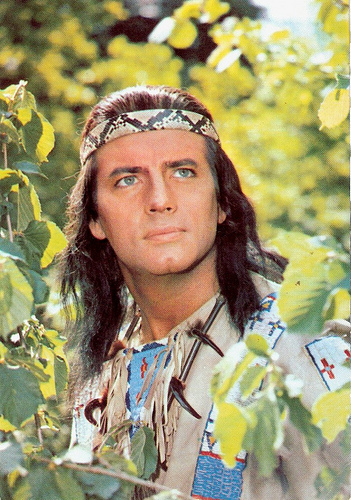
German postcard by ISV, no. R 14. Photo: publicity still for Winnetou II. Teil/Last of the Renegades (Harald Reinl, 1964) with Pierre Brice as Winnetou. Caption: "In letzter Minute rettet Winnetou seinen Blutsbruder Old Shatterhand aus den Flammen." (At the last minute Winnetou saves his blood brother Old Shatterhand from the flames)
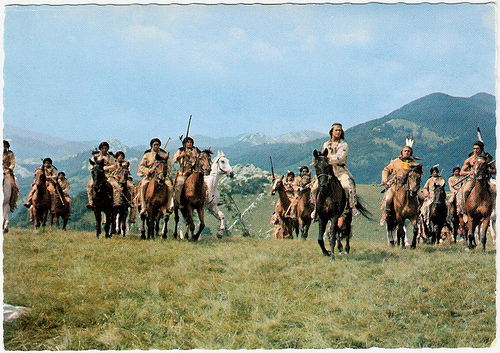
German postcard, no. R 15. Photo: still from Winnetou II (Harald Reinl, 1964) with Pierre Brice . Caption: "Winnetou, Old Shatterhand und die anderen Indianerhäuptlinge reiten zur Friedenskonferenz nach Fort Niobrara." (Winnetou, Old Shatterhand and the other Indian Chiefs ride to Fort Niobrara for the peace conference.)
A perfect money spinner
In the aftermath of the Second World War, Europe was left in ruins and so was the European cinema, especially the German film industry. There was a strong backlash against those filmmakers who had remained faithful to the Nazi party, while many of Germany's best filmmakers had moved to America in the 1930s.
In the 1950s, the German cinema struggled gradually back to form. Low budgets and at first a lack of international markets were the reasons that the most popular productions were the Heimat films and later also the Sissi films with Romy Schneider . Large audience figures meant that the film studios were gradually able to increase their budgets, and by the 1960s, big scale films were back on the cards. And even some of the directors who had fled to Hollywood returned to work in Germany, including Fritz Lang.
The Karl May novels were, and still are highly popular in the German speaking world, telling of adventurous exploits in the Wild West, the Orient. Film adaptations of the books had been made as early as the 1920s, and again in the late 1930s, and discussions had been made about shooting some of the Wild West stories - indeed a final script for a Winnetou film was approved in 1944 by Propaganda Minister Joseph Goebbels but never went into production.
Timothy Young in his Mondo Esoterica Guide to: The Karl May Westerns : "With German audiences filling cinemas, and desperately wanting more home grown films, the Karl May themes seemed like a perfect money spinner for producer Horst Wendlandt. A key player at Rialto Film, he had successfully produced a series of adult-targeted films based on the Edgar Wallace thriller/horror novels."
Wendlandt now sought to target the younger markets. His idea of shooting European Westerns was unheard of at the beginning of the 1960s - the Spaghetti Western rage started only a few years later with Sergio Leone's Per un pugno di dollari/For a fistful of Dollars (1964).
Instead of using the Spanish locations of the Spaghetti Westerns, the Karl May series was shot in Yugoslavia. Films like Winnetou II. Teil (1964) took great advantage of the barren landscapes, mountains and rivers. In return, the films made Yugoslavia a popular holiday destination for many Europeans.
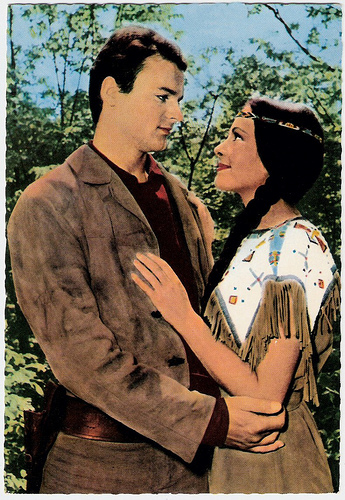
German postcard, no. R 16. Photo: publicity still from Winnetou II. Teil/Last of the Renegades (Harald Reinl, 1964) with Mario Girotti and Karin Dor . Caption: "Fast scheitern die Friedensverhandlungen. Da erklärt sich Leutnant Merril bereit, Ribanna zu heiraten, um den Friedensband zwischen Weiss und Rot zu besieglen." (Almost the peace negotiations are failing. Lieutenant Merril declares his willingness to marry Ribanna in order to conquer the peace bond between white and red.)
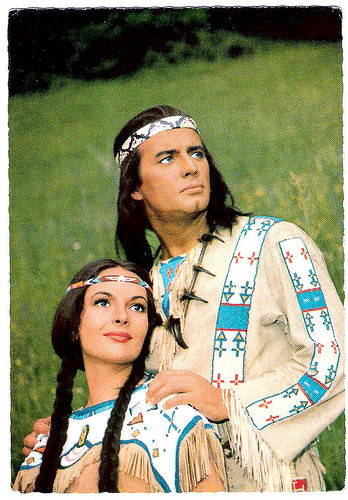
German postcard, no. R 17. Photo: publicity still for Winnetou II. Teil/Winnetou: The Red Gentleman (Harald Reinl, 1964) with Pierre Brice and Karin Dor . Caption: So werden Ribanna und Winnetou gezwungen, ihre Liebe dem Frieden zu opfern. (Thus Ribanna and Winnetou are forced to sacrifice their love.)
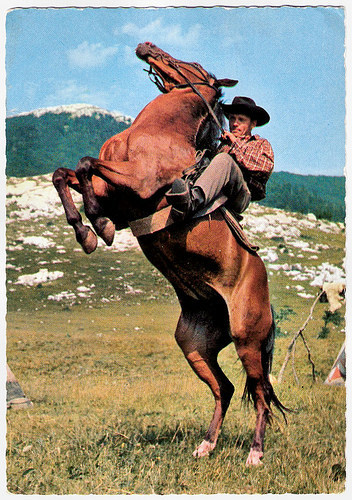
German postcard, no. R 18. Photo: publicity still for Winnetou II. Teil/Winnetou: The Red Gentleman (Harald Reinl, 1964). Caption: "Forrester sorgt für Unfrieden. Er überfällt mit seiner Bande einen Siedlertreck und hinterlässt falsche Spuren, um die Indianer in den Verdacht dieser Untat zu bringen." (Forrester is a source of dissatisfaction. He crosses a settlement with his gang, leaving behind bad traces to bring the Indians into the suspicion of this misdeed.)
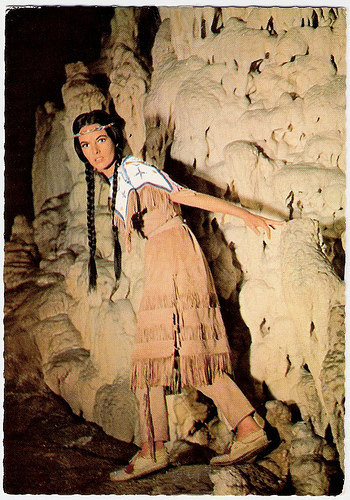
German postcard, no. R 19. Photo: still from Winnetou - II. Teil/Last of the Renegades (Harald Reinl, 1964) with Karin Dor as Ribanna. Caption: "Den Assiniboins droht Gefahr. Von Ribanna und Leutnant Merril gewarnt, werden die Frauen und Kinder noch rechtzeitig in die Höhle geführt." (The Assiniboin are in danger. Warned by Ribanna and lieutenant Merril, the women and children are led into the cave in time.)
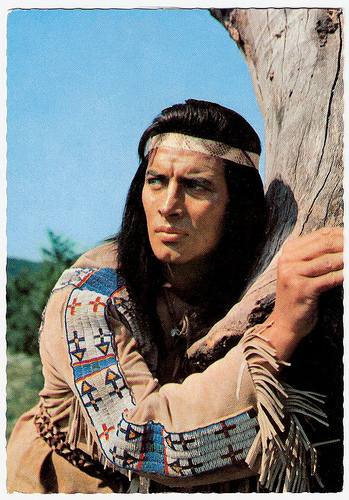
German postcard, no. R 20. Photo: publicity still for Winnetou II. Teil/Last of the Renegades (Harald Reinl, 1964) with Pierre Brice . Caption: Auf der Suche nach Forrester geraten Winnetou und Old Shatterhand in einen Hinterhalt. Durch eine List können sie in letzter Minute entkommen. (Looking for Forrester Winnetou and Old Shatterhand fall into an ambush. By a trick they can escape at the last minute.)
Winnetou's greatest love
Horst Wendlandt's first Eurowestern was, appropriately enough, Karl May's first Old West book - Der Schatz im Silbersee/The Treasure of Silver Lake (Harald Reinl, 1962). The novel had to be altered for the screen - scenes set aboard an American paddle steamer proved too much for the budget, while the graphic details of Colonel Brinkley's savage nature had to be toned down for the family market - but it still retained the charm and feel of the original stories, and proved a massive hit with audiences across Germany.
Impressively, the distinctive soundtrack proved equally popular and became a bestseller. The studio quickly commissioned a second film, and following the order of the original books Rialto produced the prequel story Winnetou 1. Teil (1963) which told the origins of the Winnetou and Old Shatterhand characters who played the major role in Der Schatz im Silbersee/The Treasure of Silver Lake , it secured actors Lex Barker and Pierre Brice in their respective roles as Old Shatterhand and Winnetou.
According to Timothy Young at the Mondo Esoterica Guide, Winnetou 1. Teil/Apache Gold (Harald Reinl, 1963) proved equally popular to the first, and stands as the best in the series - boasting a rarely bettered set piece with a full scale railway locomotive being driven through a saloon building.
Winnetou II. Teil (1964) followed on, continuing the series' popularity. Again Harald Reinl directed the sequel and he could work with a very good script by veteran author Harald G. Petterson. Composer Martin Böttcher made a new lead theme, the Winnetou-Melodie, which became massive hit.
Lex Barker and Pierre Brice were joined by a cast of excellent actors. Karin Dor plays Winnetou's greatest love Ribanna, British actor Anthony Steel plays Forester, a ruthless oil baron, and among his gang members is the enigmatic Klaus Kinski .
Lt. Robert Merril, one of the good guys is played by a blue-eyed Italian hunk called Mario Girotti , who would become one of the best-known Spaghetti Western stars under the alias Terence Hill . Also remarkable is the small part of Gojko Mitic as White Bird. The muscled Yugoslavian actor later became the superstar of the Eastern, the East-European Western. Finally there is comic actor Eddi Arent as Old Shatterhand's sidekick Lord Castlepool.
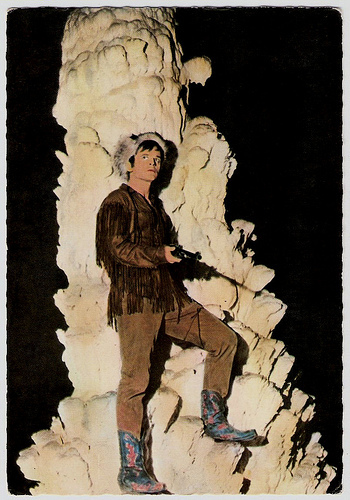
German postcard, no. R 21. Photo: publicity still for Winnetou - 2. Teil/Last of the Renegades (Harald Reinl, 1964), with Klaus Kinski . Caption: "Mit Hilfe des Bandesmitgliedes Luke spüren die Verbrecher die Höhle auf und bemächtigen sich der Frauen und Kinder des Assiniboins." (With the help of band member Luke the criminals find the cave and take possession of the women and children of the Assiniboin.)

German postcard, no. R 22. Photo: publicity still for Winnetou - 2. Teil/Last of the Renegades (Harald Reinl, 1964) with Mario Girotti and Karin Dor . Caption: "Auch Ribanna und ihr Mann Leutnant Merrill fallen in die Hände der Bande. Sie werden als Gefangene an einen Felsen gebunden." (Ribanna and her husband Lt. Merrill also fall into the hands of the gang. They are bound as prisoners to a rock.)
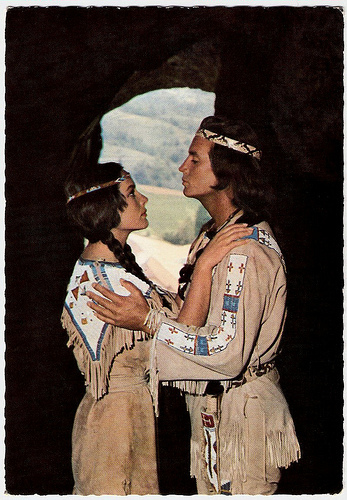
German postcard, no. R 24. Photo: still from Winnetou II. Teil/Last of the Renegades (Harald Reinl, 1964) with Karin Dor as Ribanna and Pierre Brice as Winnetou. Caption: "Bis zur Verhandlung weilt Winnetou bei den Assiniboins und lernt Ribanna näher kennen und lieben." (Winnetou is waiting for the Assiniboins and learns to know and love Ribanna.)
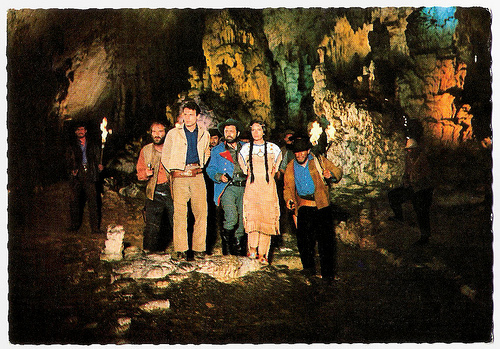
German postcard, no. R 26. Photo: publicity still for Winnetou 2. Teil/Winnetou: The Red Gentleman (Harald Reinl, 1964) with Mario Girotti , Karin Dor and Anthony Steel . Caption: "Der Skrupellose Forrester benutzt Ribanna und Leutnant Merril als Geiseln. Die Bande verlangt freien Abzug." (The unscrupulous Forrester used Ribanna and Lieutenant Merril as hostages. The gang demanded free passage.)
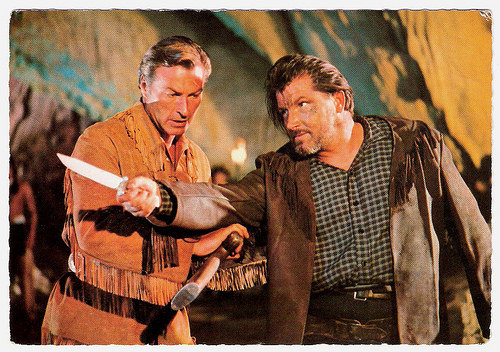
German postcard, no. R 27. Photo: publicity still for Winnetou II. Teil/Winnetou: The Red Gentleman (Harald Reinl, 1964) with Lex Barker as Old Shatterhand. Caption: "Durch einen Unterirdischen Wasserlauf gelingt es den Rettern in die Höhle einzudringen. Old Shatterhands harte Fäuste räumen unter den Banditen auf." (Through an underground watercourse the rescuers succeed to penetrate into the cave. Old Shatterhand's hard fists cleave under the bandits.)
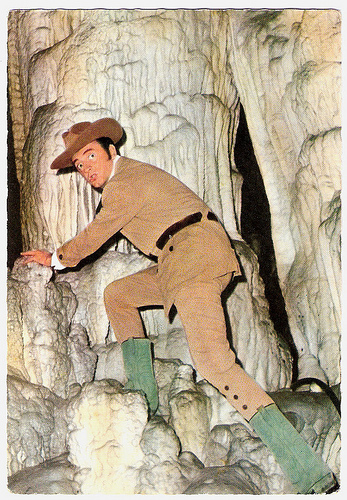
German postcard, no. R 28. Photo: publicity still for Winnetou II. Teil/ Last of the Renegades (Harald Reinl, 1964) with Eddi Arent . Caption: "Auch Lord Castlepool, der sich aus Abenteurlust Old Shatterhand angeschlossen hat, bewährt sich am Kampf gegen die Banditen." (Lord Castlepool, who has joined Old Shatterhand lusting for adventures, is also fighting against the bandits.)
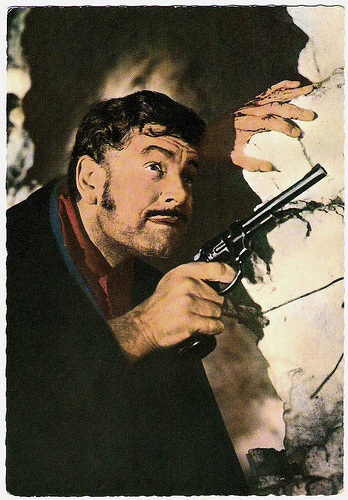
German postcard, no. R 29. Photo: publicity still for Winnetou - 2. Teil/Last of the Renegades (Harald Reinl, 1964) with Anthony Steel . Caption: "Die Bande ist vernichtet. Nur Forrester kämpft noch um sein Leben.Jedoch entgeht er nicht seinem wohlverdienten Schicksal." (The gang is destroyed. Only Forrester is still struggling for his life. However, he does not escape his well-deserved destiny.)
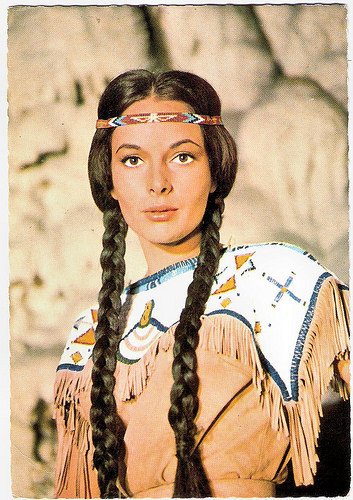
German postcard, no. R 30. Photo: publicity still for Winnetou 2. Teil/Winnetou: The Red Gentleman (Harald Reinl, 1964) with Karin Dor . Caption: "Der Friede ist gerettet. Ribanna weiss, dass ihr und Winnetous Opfer nicht umsonst war." (Peace is saved. Ribanna knows that her and Winnetou's sacrifice was not in vain.)
Sources: Timothy Young (Mondo Esoterica Guide to: The Karl May Westerns), Wikipedia (German and English) and IMDb.

German postcard, no. R 5. Photo: publicity still of Pierre Brice and Gojko Mitic in Winnetou II. Teil/Winnetou: The Red Gentleman (Harald Reinl, 1964). Caption: "Winnetou hat die Assiniboins für seine Pläne gewonnen, und man beschliesst eine Verhandlung mit den Weissen in Fort Niobara. Botschaft hierüber geht an alle Häuptlinge." (Winnetou has won the Assiniboins for his plans, and they choose for a negotiation with the white in Fort Niobara. This message goes to all chiefs.)

German postcard, no. R 7. Photo: still from Winnetou II. Teil/Last of the Renegades (Harald Reinl, 1964) with Karin Dor as Ribanna and Pierre Brice as Winnetou. Caption: "Ribanna lüftet ein Geheimnis. Sie zeigt Winnetou eine im Felsen verborgene Höhle, die in Kriegszeiten den Frauen und Kinder als Zuflkuchtsstätte dient." (Ribanna reveals a secret. She shows Winnetou a cave hidden in the rock, which in wartime serves the women and children as a refuge.)

German postcard, no R 8. Photo: publicity still for Winnetou II. Teil/Winnetou: The Red Gentleman (Harald Reinl, 1964) with Pierre Brice and Karin Dor . Caption: "Noch ahnt man nicht, wie bald von diesem Versteck Gebrauch gemacht werden muss; den Forrester, der sein dunkles Gerwerbe auf Kosten der Indianer betreibt, schmiedet schon Pläne." (Yet nobody suspects how soon this hiding place must be used; Forrester, who runs his shady business at the expense of the Indians, already makes his plans).

German postcard by ISV, no. R 14. Photo: publicity still for Winnetou II. Teil/Last of the Renegades (Harald Reinl, 1964) with Pierre Brice as Winnetou. Caption: "In letzter Minute rettet Winnetou seinen Blutsbruder Old Shatterhand aus den Flammen." (At the last minute Winnetou saves his blood brother Old Shatterhand from the flames)

German postcard, no. R 15. Photo: still from Winnetou II (Harald Reinl, 1964) with Pierre Brice . Caption: "Winnetou, Old Shatterhand und die anderen Indianerhäuptlinge reiten zur Friedenskonferenz nach Fort Niobrara." (Winnetou, Old Shatterhand and the other Indian Chiefs ride to Fort Niobrara for the peace conference.)
A perfect money spinner
In the aftermath of the Second World War, Europe was left in ruins and so was the European cinema, especially the German film industry. There was a strong backlash against those filmmakers who had remained faithful to the Nazi party, while many of Germany's best filmmakers had moved to America in the 1930s.
In the 1950s, the German cinema struggled gradually back to form. Low budgets and at first a lack of international markets were the reasons that the most popular productions were the Heimat films and later also the Sissi films with Romy Schneider . Large audience figures meant that the film studios were gradually able to increase their budgets, and by the 1960s, big scale films were back on the cards. And even some of the directors who had fled to Hollywood returned to work in Germany, including Fritz Lang.
The Karl May novels were, and still are highly popular in the German speaking world, telling of adventurous exploits in the Wild West, the Orient. Film adaptations of the books had been made as early as the 1920s, and again in the late 1930s, and discussions had been made about shooting some of the Wild West stories - indeed a final script for a Winnetou film was approved in 1944 by Propaganda Minister Joseph Goebbels but never went into production.
Timothy Young in his Mondo Esoterica Guide to: The Karl May Westerns : "With German audiences filling cinemas, and desperately wanting more home grown films, the Karl May themes seemed like a perfect money spinner for producer Horst Wendlandt. A key player at Rialto Film, he had successfully produced a series of adult-targeted films based on the Edgar Wallace thriller/horror novels."
Wendlandt now sought to target the younger markets. His idea of shooting European Westerns was unheard of at the beginning of the 1960s - the Spaghetti Western rage started only a few years later with Sergio Leone's Per un pugno di dollari/For a fistful of Dollars (1964).
Instead of using the Spanish locations of the Spaghetti Westerns, the Karl May series was shot in Yugoslavia. Films like Winnetou II. Teil (1964) took great advantage of the barren landscapes, mountains and rivers. In return, the films made Yugoslavia a popular holiday destination for many Europeans.

German postcard, no. R 16. Photo: publicity still from Winnetou II. Teil/Last of the Renegades (Harald Reinl, 1964) with Mario Girotti and Karin Dor . Caption: "Fast scheitern die Friedensverhandlungen. Da erklärt sich Leutnant Merril bereit, Ribanna zu heiraten, um den Friedensband zwischen Weiss und Rot zu besieglen." (Almost the peace negotiations are failing. Lieutenant Merril declares his willingness to marry Ribanna in order to conquer the peace bond between white and red.)

German postcard, no. R 17. Photo: publicity still for Winnetou II. Teil/Winnetou: The Red Gentleman (Harald Reinl, 1964) with Pierre Brice and Karin Dor . Caption: So werden Ribanna und Winnetou gezwungen, ihre Liebe dem Frieden zu opfern. (Thus Ribanna and Winnetou are forced to sacrifice their love.)

German postcard, no. R 18. Photo: publicity still for Winnetou II. Teil/Winnetou: The Red Gentleman (Harald Reinl, 1964). Caption: "Forrester sorgt für Unfrieden. Er überfällt mit seiner Bande einen Siedlertreck und hinterlässt falsche Spuren, um die Indianer in den Verdacht dieser Untat zu bringen." (Forrester is a source of dissatisfaction. He crosses a settlement with his gang, leaving behind bad traces to bring the Indians into the suspicion of this misdeed.)

German postcard, no. R 19. Photo: still from Winnetou - II. Teil/Last of the Renegades (Harald Reinl, 1964) with Karin Dor as Ribanna. Caption: "Den Assiniboins droht Gefahr. Von Ribanna und Leutnant Merril gewarnt, werden die Frauen und Kinder noch rechtzeitig in die Höhle geführt." (The Assiniboin are in danger. Warned by Ribanna and lieutenant Merril, the women and children are led into the cave in time.)

German postcard, no. R 20. Photo: publicity still for Winnetou II. Teil/Last of the Renegades (Harald Reinl, 1964) with Pierre Brice . Caption: Auf der Suche nach Forrester geraten Winnetou und Old Shatterhand in einen Hinterhalt. Durch eine List können sie in letzter Minute entkommen. (Looking for Forrester Winnetou and Old Shatterhand fall into an ambush. By a trick they can escape at the last minute.)
Winnetou's greatest love
Horst Wendlandt's first Eurowestern was, appropriately enough, Karl May's first Old West book - Der Schatz im Silbersee/The Treasure of Silver Lake (Harald Reinl, 1962). The novel had to be altered for the screen - scenes set aboard an American paddle steamer proved too much for the budget, while the graphic details of Colonel Brinkley's savage nature had to be toned down for the family market - but it still retained the charm and feel of the original stories, and proved a massive hit with audiences across Germany.
Impressively, the distinctive soundtrack proved equally popular and became a bestseller. The studio quickly commissioned a second film, and following the order of the original books Rialto produced the prequel story Winnetou 1. Teil (1963) which told the origins of the Winnetou and Old Shatterhand characters who played the major role in Der Schatz im Silbersee/The Treasure of Silver Lake , it secured actors Lex Barker and Pierre Brice in their respective roles as Old Shatterhand and Winnetou.
According to Timothy Young at the Mondo Esoterica Guide, Winnetou 1. Teil/Apache Gold (Harald Reinl, 1963) proved equally popular to the first, and stands as the best in the series - boasting a rarely bettered set piece with a full scale railway locomotive being driven through a saloon building.
Winnetou II. Teil (1964) followed on, continuing the series' popularity. Again Harald Reinl directed the sequel and he could work with a very good script by veteran author Harald G. Petterson. Composer Martin Böttcher made a new lead theme, the Winnetou-Melodie, which became massive hit.
Lex Barker and Pierre Brice were joined by a cast of excellent actors. Karin Dor plays Winnetou's greatest love Ribanna, British actor Anthony Steel plays Forester, a ruthless oil baron, and among his gang members is the enigmatic Klaus Kinski .
Lt. Robert Merril, one of the good guys is played by a blue-eyed Italian hunk called Mario Girotti , who would become one of the best-known Spaghetti Western stars under the alias Terence Hill . Also remarkable is the small part of Gojko Mitic as White Bird. The muscled Yugoslavian actor later became the superstar of the Eastern, the East-European Western. Finally there is comic actor Eddi Arent as Old Shatterhand's sidekick Lord Castlepool.

German postcard, no. R 21. Photo: publicity still for Winnetou - 2. Teil/Last of the Renegades (Harald Reinl, 1964), with Klaus Kinski . Caption: "Mit Hilfe des Bandesmitgliedes Luke spüren die Verbrecher die Höhle auf und bemächtigen sich der Frauen und Kinder des Assiniboins." (With the help of band member Luke the criminals find the cave and take possession of the women and children of the Assiniboin.)

German postcard, no. R 22. Photo: publicity still for Winnetou - 2. Teil/Last of the Renegades (Harald Reinl, 1964) with Mario Girotti and Karin Dor . Caption: "Auch Ribanna und ihr Mann Leutnant Merrill fallen in die Hände der Bande. Sie werden als Gefangene an einen Felsen gebunden." (Ribanna and her husband Lt. Merrill also fall into the hands of the gang. They are bound as prisoners to a rock.)

German postcard, no. R 24. Photo: still from Winnetou II. Teil/Last of the Renegades (Harald Reinl, 1964) with Karin Dor as Ribanna and Pierre Brice as Winnetou. Caption: "Bis zur Verhandlung weilt Winnetou bei den Assiniboins und lernt Ribanna näher kennen und lieben." (Winnetou is waiting for the Assiniboins and learns to know and love Ribanna.)

German postcard, no. R 26. Photo: publicity still for Winnetou 2. Teil/Winnetou: The Red Gentleman (Harald Reinl, 1964) with Mario Girotti , Karin Dor and Anthony Steel . Caption: "Der Skrupellose Forrester benutzt Ribanna und Leutnant Merril als Geiseln. Die Bande verlangt freien Abzug." (The unscrupulous Forrester used Ribanna and Lieutenant Merril as hostages. The gang demanded free passage.)

German postcard, no. R 27. Photo: publicity still for Winnetou II. Teil/Winnetou: The Red Gentleman (Harald Reinl, 1964) with Lex Barker as Old Shatterhand. Caption: "Durch einen Unterirdischen Wasserlauf gelingt es den Rettern in die Höhle einzudringen. Old Shatterhands harte Fäuste räumen unter den Banditen auf." (Through an underground watercourse the rescuers succeed to penetrate into the cave. Old Shatterhand's hard fists cleave under the bandits.)

German postcard, no. R 28. Photo: publicity still for Winnetou II. Teil/ Last of the Renegades (Harald Reinl, 1964) with Eddi Arent . Caption: "Auch Lord Castlepool, der sich aus Abenteurlust Old Shatterhand angeschlossen hat, bewährt sich am Kampf gegen die Banditen." (Lord Castlepool, who has joined Old Shatterhand lusting for adventures, is also fighting against the bandits.)

German postcard, no. R 29. Photo: publicity still for Winnetou - 2. Teil/Last of the Renegades (Harald Reinl, 1964) with Anthony Steel . Caption: "Die Bande ist vernichtet. Nur Forrester kämpft noch um sein Leben.Jedoch entgeht er nicht seinem wohlverdienten Schicksal." (The gang is destroyed. Only Forrester is still struggling for his life. However, he does not escape his well-deserved destiny.)

German postcard, no. R 30. Photo: publicity still for Winnetou 2. Teil/Winnetou: The Red Gentleman (Harald Reinl, 1964) with Karin Dor . Caption: "Der Friede ist gerettet. Ribanna weiss, dass ihr und Winnetous Opfer nicht umsonst war." (Peace is saved. Ribanna knows that her and Winnetou's sacrifice was not in vain.)
Sources: Timothy Young (Mondo Esoterica Guide to: The Karl May Westerns), Wikipedia (German and English) and IMDb.
Published on April 26, 2017 22:00
April 25, 2017
Ilona Béres
Ilona Béres (1942) is a well-known film and television actress in Hungary. She appeared in many popular Hungarian films of the 1960s.
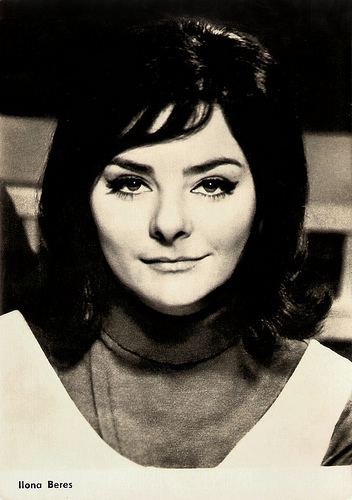
East-German postcard by VEB Progress Filmvertrieb, Berlin. no. 2208, 1964. Photo: publicity still for Nappali sötétség/Darkness in Daytime (Zoltan Fabri, 1963).
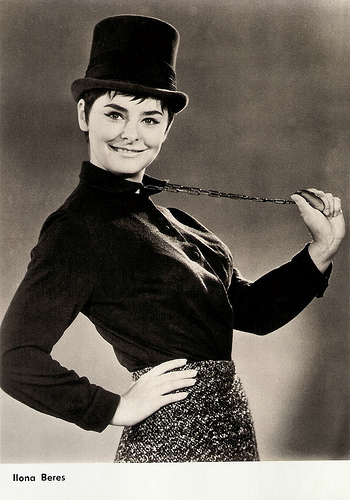
East-German postcard by VEB Progress Filmvertrieb, Berlin. no. 2620, 1966. Photo: Hungarofilm.
The Man of Gold
Ilona Béres was born in 1942 in Kispest (now Budapest), Hungary. She went to study at the Theatre and Film Academy in Budapest, where legendary director Géza Pártos was one of her teachers.
Only 20, she had her breakthrough in the Hungarian historical film Az aranvember/The Man of Gold (Viktor Gertler, 1962), also starring András Csorba and Ernö Szabó. The film was shot in anamorphic widescreen and was based on Mór Jókai's classic 19th century novel which has been adapted for the screen several times.
Popular was also the romantic comedy Esös vasárnap/Rainy Sunday (Márton Keleti, 1962) with Teri Tordai. Another success was the drama Nappali sötétség/Darkness in Daytime (Zoltán Fábri, 1963).
So, when she graduated from the Theatre and Film Academy in 1964, she was already an acclaimed actress.
In the following decades, she was member of the following theatre companies: Csokonai Theatre in Debrecen (1964-1966), Madách Theatre in Budapest (1966-1967), National Theatre in Budapest (1967-1969), and Vígszínház (1969-1984). In 1984, she returned to the National Theatre.
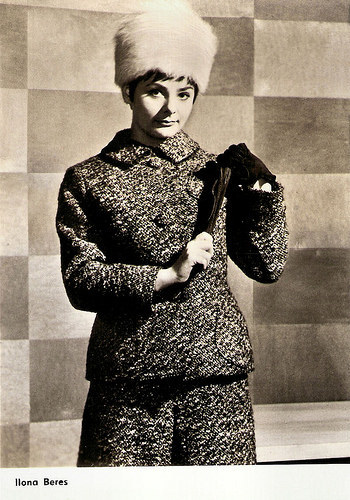
East-German postcard by VEB Progress Filmvertrieb, Berlin. no. 2754, 1967. Photo: Hungarofilm. Publicity still for Igen/Yes (György Révész, 1964).
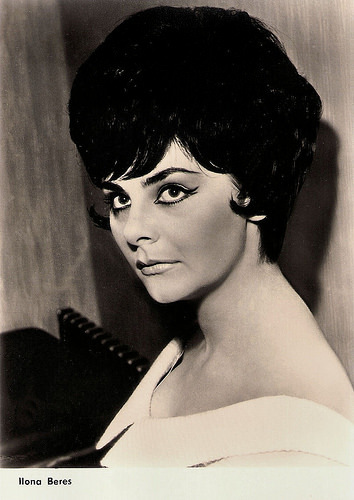
East-German postcard by VEB Progress Filmvertrieb, Berlin. no. 2334, 1965. Photo: Balinski.
Yes
The film career of Ilona Béres thrived well during the early 1960s. Her best known films of this decade include Hattyúdal/Swan Song (Márton Keleti, 1964) with Antal Pager, the drama Igen/Yes (György Révész, 1964) with Iván Darvas, and Álmodozások kora/Age of Illusions (Felnott kamaszok) (1965), the first feature-film effort by writer/director Istvan Szabo.
In Álmodozások kora/Age of Illusions, Andras Balint plays an electrical engineer who hops from bed to bed, never making any lasting commitment with any one woman. All this changes when he falls in love with a local celebrity whom he sees on television (Beres).
She also appeared in the historical drama A köszívü ember fiai/Men and Banners (Zoltán Várkonyi, 1965) about a family struggle during the 1848 Hungarian revolution against the Habsburg Empire. Other films from the 1960s include Aranysárkány/The Golden Kite (László Ranódy, Imre Gyöngyössy, 1966) and N.N. a halál angyala (János Herskó, 1970) with Miklós Gábor.
From then ons she worked mostly for television and the stage. She also worked as a voice actress for such animation films as Macskafogó/Cat City (Béla Ternovszky, 1986). Her latest film role was in the hit comedy Moszkva tér/Moscow Square (Ferenc Török, 2001), named after Moscow Square in Budapest. The film is about a group of high school students who would rather party than take notice of the history taking place all round them in 1989.
Nowadays, Ilona Béres is still very active, but mostly on stage. She is a life member of the National Theatre, which was renamed to Pesti Magyar Theatre in 2000. In 2000, she was awarded the Kossuth Award. Since 2000, she is also president of the MASZK, the Hungarian Actors Guild.
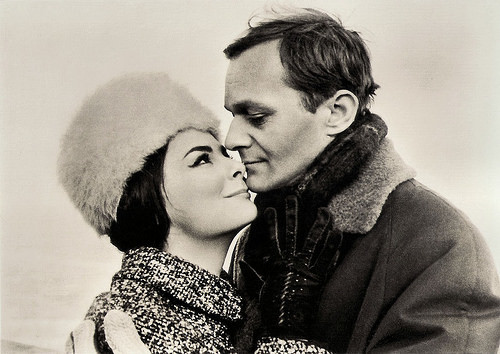
East-German postcard by VEB Progress Filmvertrieb, Berlin. no. 2.333, 1965. Publicity still for Igen/Yes (György Révész, 1964) with Iván Darvas.
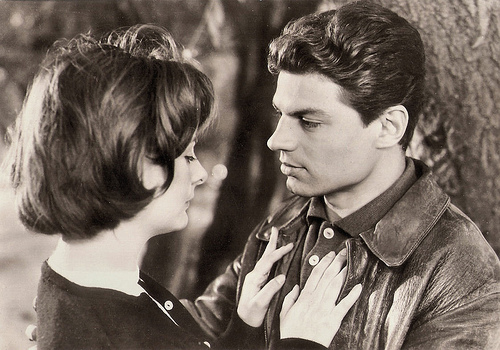
East-German postcard by VEB Progress Filmvertrieb, Berlin. no. 2773, 1967. Photo: publicity still for Szentjános fejevétele/St. John's head reception (Márk Novák, 1966) with Istvan Szankay.
Sources: Hal Erickson (AllMovie), Wikipedia, and .

East-German postcard by VEB Progress Filmvertrieb, Berlin. no. 2208, 1964. Photo: publicity still for Nappali sötétség/Darkness in Daytime (Zoltan Fabri, 1963).

East-German postcard by VEB Progress Filmvertrieb, Berlin. no. 2620, 1966. Photo: Hungarofilm.
The Man of Gold
Ilona Béres was born in 1942 in Kispest (now Budapest), Hungary. She went to study at the Theatre and Film Academy in Budapest, where legendary director Géza Pártos was one of her teachers.
Only 20, she had her breakthrough in the Hungarian historical film Az aranvember/The Man of Gold (Viktor Gertler, 1962), also starring András Csorba and Ernö Szabó. The film was shot in anamorphic widescreen and was based on Mór Jókai's classic 19th century novel which has been adapted for the screen several times.
Popular was also the romantic comedy Esös vasárnap/Rainy Sunday (Márton Keleti, 1962) with Teri Tordai. Another success was the drama Nappali sötétség/Darkness in Daytime (Zoltán Fábri, 1963).
So, when she graduated from the Theatre and Film Academy in 1964, she was already an acclaimed actress.
In the following decades, she was member of the following theatre companies: Csokonai Theatre in Debrecen (1964-1966), Madách Theatre in Budapest (1966-1967), National Theatre in Budapest (1967-1969), and Vígszínház (1969-1984). In 1984, she returned to the National Theatre.

East-German postcard by VEB Progress Filmvertrieb, Berlin. no. 2754, 1967. Photo: Hungarofilm. Publicity still for Igen/Yes (György Révész, 1964).

East-German postcard by VEB Progress Filmvertrieb, Berlin. no. 2334, 1965. Photo: Balinski.
Yes
The film career of Ilona Béres thrived well during the early 1960s. Her best known films of this decade include Hattyúdal/Swan Song (Márton Keleti, 1964) with Antal Pager, the drama Igen/Yes (György Révész, 1964) with Iván Darvas, and Álmodozások kora/Age of Illusions (Felnott kamaszok) (1965), the first feature-film effort by writer/director Istvan Szabo.
In Álmodozások kora/Age of Illusions, Andras Balint plays an electrical engineer who hops from bed to bed, never making any lasting commitment with any one woman. All this changes when he falls in love with a local celebrity whom he sees on television (Beres).
She also appeared in the historical drama A köszívü ember fiai/Men and Banners (Zoltán Várkonyi, 1965) about a family struggle during the 1848 Hungarian revolution against the Habsburg Empire. Other films from the 1960s include Aranysárkány/The Golden Kite (László Ranódy, Imre Gyöngyössy, 1966) and N.N. a halál angyala (János Herskó, 1970) with Miklós Gábor.
From then ons she worked mostly for television and the stage. She also worked as a voice actress for such animation films as Macskafogó/Cat City (Béla Ternovszky, 1986). Her latest film role was in the hit comedy Moszkva tér/Moscow Square (Ferenc Török, 2001), named after Moscow Square in Budapest. The film is about a group of high school students who would rather party than take notice of the history taking place all round them in 1989.
Nowadays, Ilona Béres is still very active, but mostly on stage. She is a life member of the National Theatre, which was renamed to Pesti Magyar Theatre in 2000. In 2000, she was awarded the Kossuth Award. Since 2000, she is also president of the MASZK, the Hungarian Actors Guild.

East-German postcard by VEB Progress Filmvertrieb, Berlin. no. 2.333, 1965. Publicity still for Igen/Yes (György Révész, 1964) with Iván Darvas.

East-German postcard by VEB Progress Filmvertrieb, Berlin. no. 2773, 1967. Photo: publicity still for Szentjános fejevétele/St. John's head reception (Márk Novák, 1966) with Istvan Szankay.
Sources: Hal Erickson (AllMovie), Wikipedia, and .
Published on April 25, 2017 22:00
April 24, 2017
Constance Collier
Constance Collier (1878–1955) was an English stage and film actress and later one of Hollywood's premiere drama and voice coaches. In a career that covered six decades, she evolved into one of London’s and Broadway’s finest tragediennes. Although she appeared in a number of silent British and American films, her career in the cinema got really on steam in her senior years when Collier appeared in well-regarded supporting roles in more than twenty Hollywood productions.
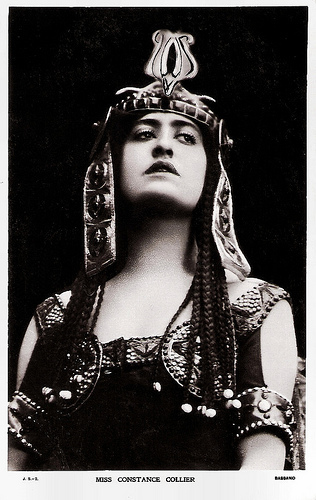
British postcard by J.J. Samuels, London, no. J.S.-2. Photo: Bassano. Publicity still for the stage production Antony and Cleopatra (1906) with Constance Collier as Cleopatra.
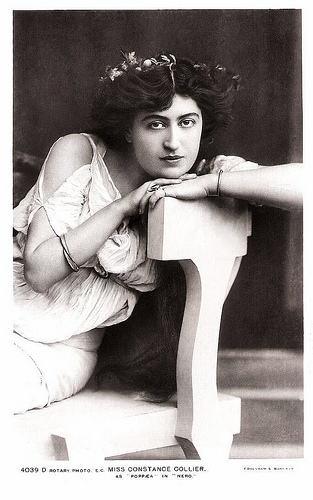
British postcard by Rotary Photo, no. 4039 D. Photo: Foulsham & Banfield. Publicity still for the stage play Nero (1906) with Constance Collier as Poppaea.
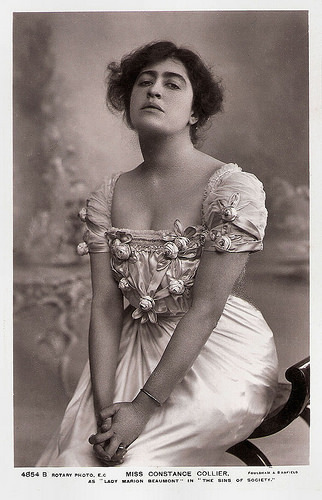
British postcard by Rotary Photo, no. 854B. Photo: Foulsham & Banfield. Publicity still for the stage play The Sins of Society (1907) with Constance Collier as Lady Marion Beaumont.
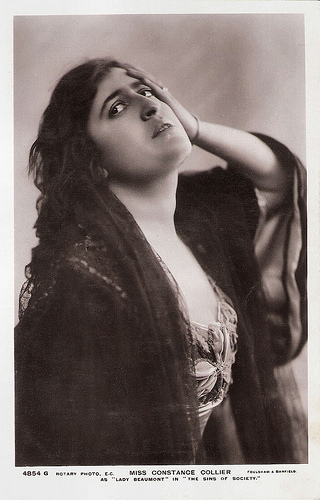
British postcard by Rotary Photo, no. 5854 G. Photo: Foulsham & Banfield. Publicity still for the stage play The Sins of Society (1907) with Constance Collier as Lady Marion Beaumont.
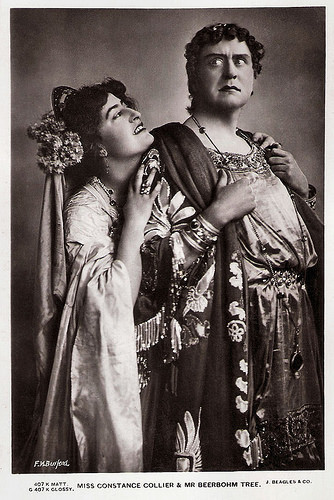
British postcard by Beagles & Co., London no. G 407. Photo: F.W. Burford. Publicity still for the stage production Nero (1906) with Herbert Beerbohm Tree as Nero and Constance Collier as Poppoea, a part she created for the stage. Stephen Phillips’ Nero opened at His Majesty’s Theatre, London, in 1906.
A Gaiety Girl
In 1878, Constance Collier was born Laura Constance Hardie, in Windsor, Berkshire. She was the only child of Cheetham Agaste Hardie and Eliza Collier, both minor professional actors.
Constance made her stage debut at the age of 3, when she played Fairy Peasblossom in A Midsummer's Night Dream. In 1893, at the age of 15, she joined the famous Gaiety Girls dance troupe of George Edwardes-Hall, based at the Gaiety Theatre in London. Groomed extensively in singing, dancing and elocution, she managed to stand out among those others in the chorus line and went on to featured status in two of Edwardes-Hall's biggest hits, A Gaiety Girl (1894) and The Shop Girl (1894).
In addition, she had an enormous personality and considerable determination. Just after the turn of the century, she was invited to join the theatre company of the esteemed Herbert Beerbohm Tree , who had been searching for a comparably tall leading lady to play opposite him.
In 1905, Collier married handsome English actor Julian Boyle (stage name Julian L'Estrange). They performed together for many years until his death in 1918 in New York from the deadly Spanish influenza. No children were born from the marriage.
In 1906, Beerbohm Tree's extravagant revival of Antony and Cleopatra opened at His Majesty's Theatre, with Tree as Mark Antony and Constance Collier as Cleopatra, a performance for which she received much critical praise. Collier was now established as a popular and distinguished actress. In 1908, she starred with Beerbohm Tree at His Majesty's Theatre in J. Comyn's new play The Mystery of Edwin Drood, based on Charles Dickens's unfinished novel.
Later that year, she made the first of several tours of the United States. Collier made a successful American stage debut in 1908 with Samson at the Garrick Theatre in New York opposite well-known American actor/playwright William Gillette. During the second tour, made with Beerbohm Tree in 1916, she appeared in four silent films.
Her film debut was The Tongues of Men (Frank Lloyd, 1916), based on a 1913 Broadway play by Edward Childs Carpenter. The other films were the romantic crime drama The Code of Marcia Gray (Frank Lloyd, 1916), Macbeth (John Emerson, assisted by Erich von Stroheim, 1919) as Lady Macbeth opposite Herbert Beerbohm Tree , and an uncredited appearance in Intolerance (D. W. Griffith, 1916). She can be seen being carried through the entrance to the city in the Babylonian part of the film.
She later starred in the British silent films The Impossible Woman (Meyrick Milton, 1919), and Bleak House (Maurice Elvey, 1920) - one of the many silent film versions of Charles Dickens' stories.
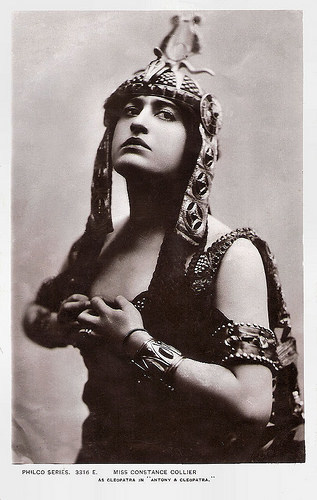
British postcard by The Philco Publishing Co., London, no. 3316 E. Photo: Bassano. Publicity still for the stage production Antony and Cleopatra (1906) with Constance Collier as Cleopatra.
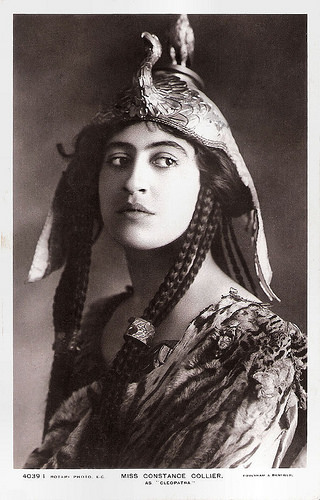
British postcard by Rotary Photo, no. 4039 I. Photo: Foulsham & Banfield. Publicity still for the stage production Antony and Cleopatra (1906) with Constance Collier as Cleopatra.
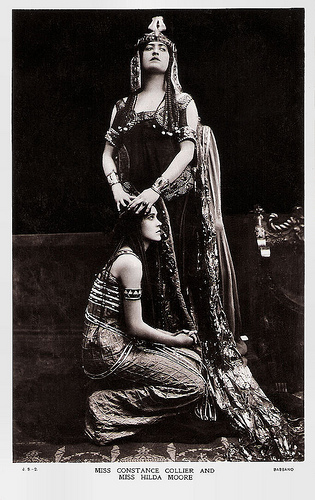
British postcard by J.J. Samuels, London, no. J.S.-2. Photo: Bassano. Publicity still for the stage production Antony and Cleopatra (1906) with Constance Collier and Hilda Moore.
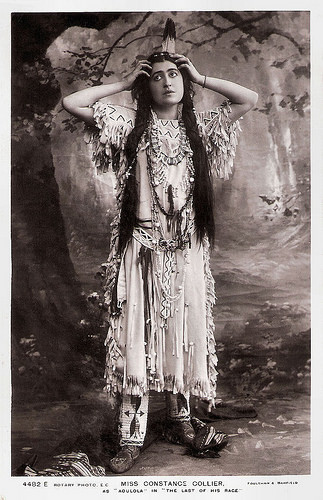
British postcard by Rotary Photo, no. 4482 E. Photo: Foulsham & Banfield. Publicity still for the stage production The Last of His Race (1907) with Constance Collier as Adulola.
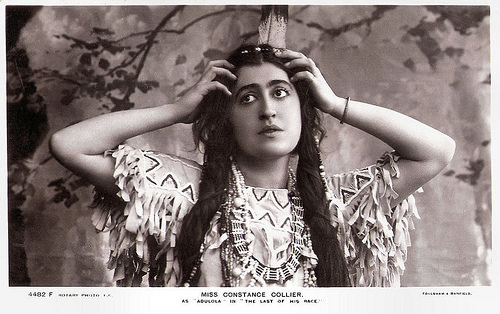
British postcard by Rotary Photo, no. 4482 F. Photo: Foulsham & Banfield. Publicity still for the stage production The Last of His Race (1907) with Constance Collier as Adulola..
Voice coach in Hollywood
In the early 1920s, Constance Collier established a close friendship with Ivor Novello , who was then a young, handsome actor. They appeared together in the film The Bohemian Girl (Harley Knoles, 1922), starring Gladys Cooper . Novello’s first play, The Rat, was written in collaboration with her in 1924. She also appeared in several plays with him, including the British version of the American success The Firebrand by Edwin Justus Mayer.
In the late 1920s Collier relocated to Hollywood where she became a voice coach and teacher in diction. This was during the tumultuous changeover from silent films to sound and many silent actors with no theatre training were scrambling for lessons. Her most famous pupil was arguably Colleen Moore. In 1935, upon her arrival in Hollywood, Luise Rainer hired Collier to improve Rainer's theatre acting and English, and to learn the basics of film acting.
Collier nevertheless maintained ties to Broadway and would appear in several plays in the 1930s. Her writing career is notable for her collaboration with Deems Taylor on the libretto of the opera Peter Ibbetson which was premiered at the Metropolitan Opera in February 1931 and which received mixed reviews.
In 1932 Collier starred as Carlotta Vance in the original production of George S. Kaufman and Edna Ferber's comedy Dinner at Eight. The role was played in the 1933 film version by Marie Dressler.
Collier appeared in more than 20 Hollywood films, including Stage Door (Gregory La Cava, 1937) starring Katharine Hepburn, Kitty (Mitchell Leisen, 1945) as the comic Lady Susan, the drunken aunt of Ray Milland , Perils of Pauline (George Marshall, 1947) with Betty Hutton, Rope (Alfred Hitchcock, 1948) and Whirlpool (Otto Preminger, 1949).
Constance Collier was presented with the American Shakespeare Festival Theatre Award for distinguished service in training and guiding actors in Shakespearean roles. Collier was a drama coach for many famous actors, including Audrey Hepburn , Vivien Leigh and Marilyn Monroe . She also coached Katharine Hepburn during Hepburn's world tour performing Shakespeare in the 1950s.
Constance Collier died of natural causes in Manhattan in 1955 at age of 77. The marriage to L'Estrange produced no children and she never remarried. Katharine Hepburn ‘inherited’ Collier's secretary Phyllis Wilbourn, who remained with Hepburn as her secretary for 40 years. Collier has a star on the Hollywood Walk of Fame.
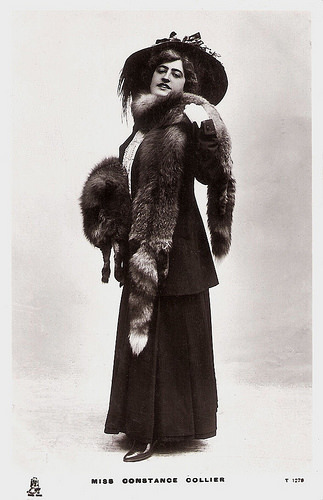
British postcard by Raphael Tuck and Sons, no. T 1278. Photo: Rover Street Studios.
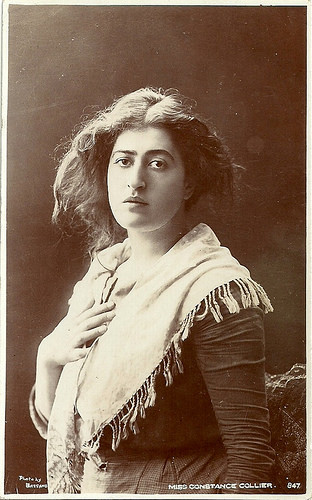
British postcard. A.G. Taylor's Royalty Series, No. 847. Photo Bassano.
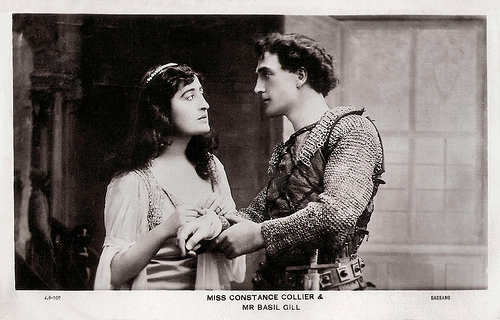
British postcard by J.J. Samuels, London, no. 4-8-102. Photo: Bassano.
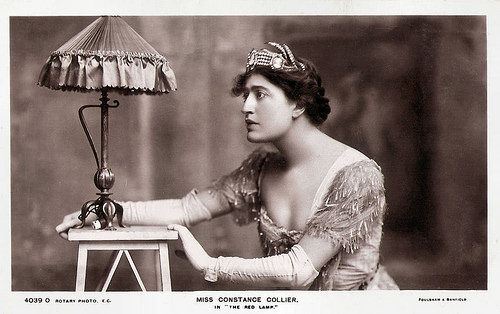
British postcard by Rotary Photo EC, No. 4039 O. Photo: Foulsham & Banfield. Constance Collier in the play The Red Lamp (1907)
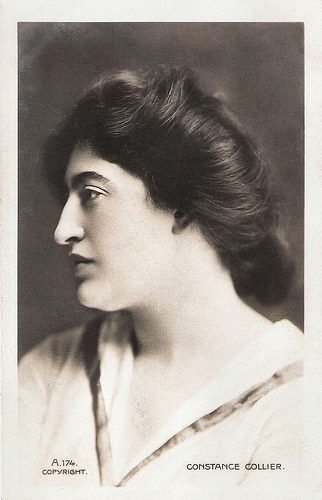
British postcard by Ralph Dunn & Co., London, no. A. 174. Sent by mail in 1905.
Sources: (IMDb), Wikipedia and .

British postcard by J.J. Samuels, London, no. J.S.-2. Photo: Bassano. Publicity still for the stage production Antony and Cleopatra (1906) with Constance Collier as Cleopatra.

British postcard by Rotary Photo, no. 4039 D. Photo: Foulsham & Banfield. Publicity still for the stage play Nero (1906) with Constance Collier as Poppaea.

British postcard by Rotary Photo, no. 854B. Photo: Foulsham & Banfield. Publicity still for the stage play The Sins of Society (1907) with Constance Collier as Lady Marion Beaumont.

British postcard by Rotary Photo, no. 5854 G. Photo: Foulsham & Banfield. Publicity still for the stage play The Sins of Society (1907) with Constance Collier as Lady Marion Beaumont.

British postcard by Beagles & Co., London no. G 407. Photo: F.W. Burford. Publicity still for the stage production Nero (1906) with Herbert Beerbohm Tree as Nero and Constance Collier as Poppoea, a part she created for the stage. Stephen Phillips’ Nero opened at His Majesty’s Theatre, London, in 1906.
A Gaiety Girl
In 1878, Constance Collier was born Laura Constance Hardie, in Windsor, Berkshire. She was the only child of Cheetham Agaste Hardie and Eliza Collier, both minor professional actors.
Constance made her stage debut at the age of 3, when she played Fairy Peasblossom in A Midsummer's Night Dream. In 1893, at the age of 15, she joined the famous Gaiety Girls dance troupe of George Edwardes-Hall, based at the Gaiety Theatre in London. Groomed extensively in singing, dancing and elocution, she managed to stand out among those others in the chorus line and went on to featured status in two of Edwardes-Hall's biggest hits, A Gaiety Girl (1894) and The Shop Girl (1894).
In addition, she had an enormous personality and considerable determination. Just after the turn of the century, she was invited to join the theatre company of the esteemed Herbert Beerbohm Tree , who had been searching for a comparably tall leading lady to play opposite him.
In 1905, Collier married handsome English actor Julian Boyle (stage name Julian L'Estrange). They performed together for many years until his death in 1918 in New York from the deadly Spanish influenza. No children were born from the marriage.
In 1906, Beerbohm Tree's extravagant revival of Antony and Cleopatra opened at His Majesty's Theatre, with Tree as Mark Antony and Constance Collier as Cleopatra, a performance for which she received much critical praise. Collier was now established as a popular and distinguished actress. In 1908, she starred with Beerbohm Tree at His Majesty's Theatre in J. Comyn's new play The Mystery of Edwin Drood, based on Charles Dickens's unfinished novel.
Later that year, she made the first of several tours of the United States. Collier made a successful American stage debut in 1908 with Samson at the Garrick Theatre in New York opposite well-known American actor/playwright William Gillette. During the second tour, made with Beerbohm Tree in 1916, she appeared in four silent films.
Her film debut was The Tongues of Men (Frank Lloyd, 1916), based on a 1913 Broadway play by Edward Childs Carpenter. The other films were the romantic crime drama The Code of Marcia Gray (Frank Lloyd, 1916), Macbeth (John Emerson, assisted by Erich von Stroheim, 1919) as Lady Macbeth opposite Herbert Beerbohm Tree , and an uncredited appearance in Intolerance (D. W. Griffith, 1916). She can be seen being carried through the entrance to the city in the Babylonian part of the film.
She later starred in the British silent films The Impossible Woman (Meyrick Milton, 1919), and Bleak House (Maurice Elvey, 1920) - one of the many silent film versions of Charles Dickens' stories.

British postcard by The Philco Publishing Co., London, no. 3316 E. Photo: Bassano. Publicity still for the stage production Antony and Cleopatra (1906) with Constance Collier as Cleopatra.

British postcard by Rotary Photo, no. 4039 I. Photo: Foulsham & Banfield. Publicity still for the stage production Antony and Cleopatra (1906) with Constance Collier as Cleopatra.

British postcard by J.J. Samuels, London, no. J.S.-2. Photo: Bassano. Publicity still for the stage production Antony and Cleopatra (1906) with Constance Collier and Hilda Moore.

British postcard by Rotary Photo, no. 4482 E. Photo: Foulsham & Banfield. Publicity still for the stage production The Last of His Race (1907) with Constance Collier as Adulola.

British postcard by Rotary Photo, no. 4482 F. Photo: Foulsham & Banfield. Publicity still for the stage production The Last of His Race (1907) with Constance Collier as Adulola..
Voice coach in Hollywood
In the early 1920s, Constance Collier established a close friendship with Ivor Novello , who was then a young, handsome actor. They appeared together in the film The Bohemian Girl (Harley Knoles, 1922), starring Gladys Cooper . Novello’s first play, The Rat, was written in collaboration with her in 1924. She also appeared in several plays with him, including the British version of the American success The Firebrand by Edwin Justus Mayer.
In the late 1920s Collier relocated to Hollywood where she became a voice coach and teacher in diction. This was during the tumultuous changeover from silent films to sound and many silent actors with no theatre training were scrambling for lessons. Her most famous pupil was arguably Colleen Moore. In 1935, upon her arrival in Hollywood, Luise Rainer hired Collier to improve Rainer's theatre acting and English, and to learn the basics of film acting.
Collier nevertheless maintained ties to Broadway and would appear in several plays in the 1930s. Her writing career is notable for her collaboration with Deems Taylor on the libretto of the opera Peter Ibbetson which was premiered at the Metropolitan Opera in February 1931 and which received mixed reviews.
In 1932 Collier starred as Carlotta Vance in the original production of George S. Kaufman and Edna Ferber's comedy Dinner at Eight. The role was played in the 1933 film version by Marie Dressler.
Collier appeared in more than 20 Hollywood films, including Stage Door (Gregory La Cava, 1937) starring Katharine Hepburn, Kitty (Mitchell Leisen, 1945) as the comic Lady Susan, the drunken aunt of Ray Milland , Perils of Pauline (George Marshall, 1947) with Betty Hutton, Rope (Alfred Hitchcock, 1948) and Whirlpool (Otto Preminger, 1949).
Constance Collier was presented with the American Shakespeare Festival Theatre Award for distinguished service in training and guiding actors in Shakespearean roles. Collier was a drama coach for many famous actors, including Audrey Hepburn , Vivien Leigh and Marilyn Monroe . She also coached Katharine Hepburn during Hepburn's world tour performing Shakespeare in the 1950s.
Constance Collier died of natural causes in Manhattan in 1955 at age of 77. The marriage to L'Estrange produced no children and she never remarried. Katharine Hepburn ‘inherited’ Collier's secretary Phyllis Wilbourn, who remained with Hepburn as her secretary for 40 years. Collier has a star on the Hollywood Walk of Fame.

British postcard by Raphael Tuck and Sons, no. T 1278. Photo: Rover Street Studios.

British postcard. A.G. Taylor's Royalty Series, No. 847. Photo Bassano.

British postcard by J.J. Samuels, London, no. 4-8-102. Photo: Bassano.

British postcard by Rotary Photo EC, No. 4039 O. Photo: Foulsham & Banfield. Constance Collier in the play The Red Lamp (1907)

British postcard by Ralph Dunn & Co., London, no. A. 174. Sent by mail in 1905.
Sources: (IMDb), Wikipedia and .
Published on April 24, 2017 22:00
April 23, 2017
Exported to the USA: Ann-Margret
Ann-Margret (1941) is a Swedish-American actress, singer and dancer, with a career that spans five decades. Her trademarks are her breathless voice, strawberry blonde hair and voluptuous figure which lead to the nickname 'sex kitten'.
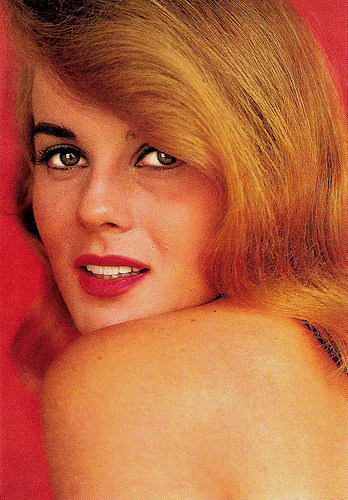
Spanish postcard by Postal Oscarcolor, S.L., no. 336.
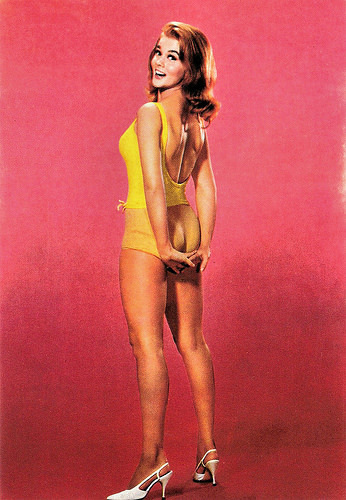
Italian postcard. Photo: Metro-Goldwyn-Mayer. Publicity still for Made in Paris (Boris Sagal, 1966).
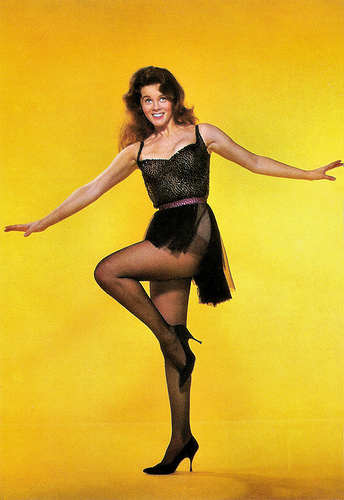
Spanish postcard by Postal Oscarcolor, no. 018-65.
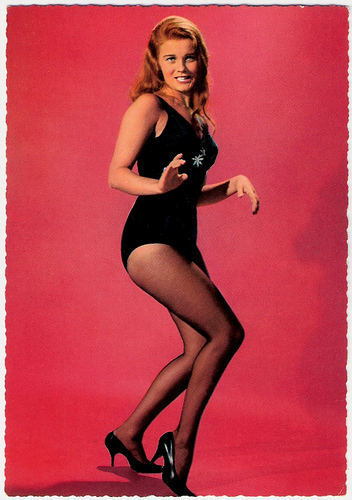
German postcard by Krüger, no. 902/250.
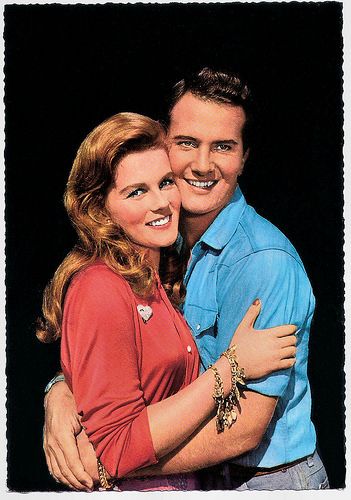
German postcard by Krüger, no. 902/263. Photo: publicity still for State Fair (José Ferrer, 1962) with Pat Boone.
Born in Sweden
Ann-Margret Olsson was born in Valsjöbyn, Jämtland County, Sweden in 1941. Her parents were Anna Regina (Aronsson) and Carl Gustav Olsson. Her father worked in the United States during his youth and moved there again in 1942, working with the Johnson Electrical Company, while his wife and daughter stayed behind.
Mother and daughter came to America in 1946. Her father took his daughter to Radio City Music Hall on the day they arrived. They settled just outside Chicago, in Wilmette, Illinois. She became a naturalised citizen of the United States in 1949 and took her first dance lessons at the Marjorie Young School of Dance. While she attended New Trier High School in Winnetka, Illinois, she starred in theatricals.
As part of a group known as the Suttletones, she performed at the Mist, a Chicago nightclub. The group finally arrived at the Dunes in Las Vegas. There, Ann-Margret was discovered by George Burns and soon afterwards got both a record deal at RCA. In 1961, her single I Just Don't Understand charted in the Top 20 of the Billboard Hot 100.
That same year, Ann-Margret filmed a screen test at 20th Century Fox and was signed to a seven-year contract. She made her film debut in Pocketful of Miracles (1961), with Bette Davis. It was a remake of Lady for a Day (1933). Both versions were directed by Frank Capra. Then came a remake of Rodgers and Hammerstein's musical State Fair (José Ferrer, 1962), playing the 'bad girl' role of Emily opposite Bobby Darin and Pat Boone. It was considered to be a financially and critically flop.
Her next starring role, as the all-American teenager Kim from Sweet Apple, Ohio, in Bye Bye Birdie (George Sidney, 1963), made her a major star. She became a teen idol with her role in Viva Las Vegas (George Sidney, 1964) with Elvis Presley. While working on the film Once a Thief (Ralph Nelson, 1965), with Alain Delon , she met future husband Roger Smith, known for his starring role in the private-eye television series 77 Sunset Strip.
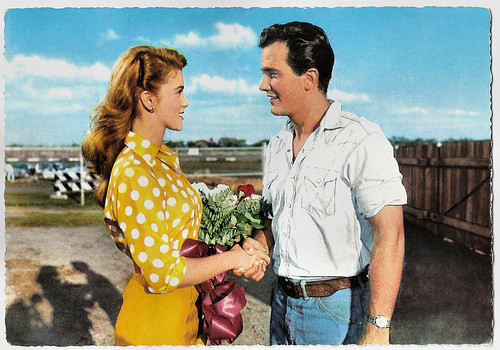
German postcard by Krüger, no. 902/262. Photo: publicity still for State Fair (José Ferrer, 1962) with Pat Boone.
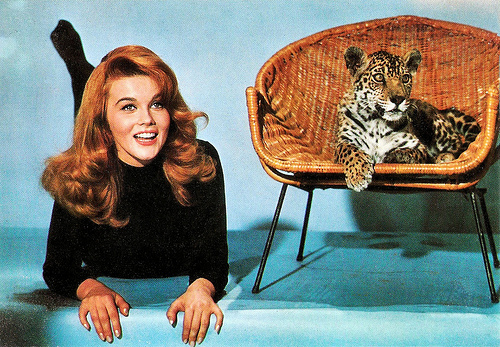
Spanish postcard by Postal Oscarcolor, S.L., no. 27. Photo: Universal Pictures. Publicity still for Kitten with a Whip (Douglas Heyes, 1964).
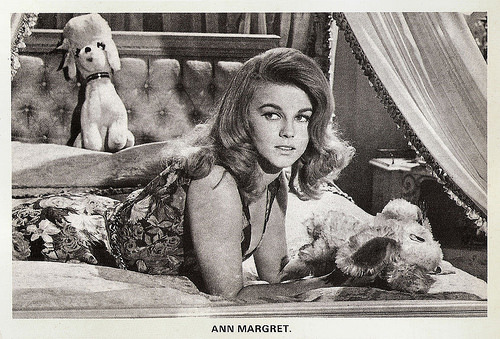
Spanish postcard by Productos Compactos, S.A., no. B 3789-1991. Photo: publicity still for Bus Riley's Back in Town (Harvey Hart, 1965).
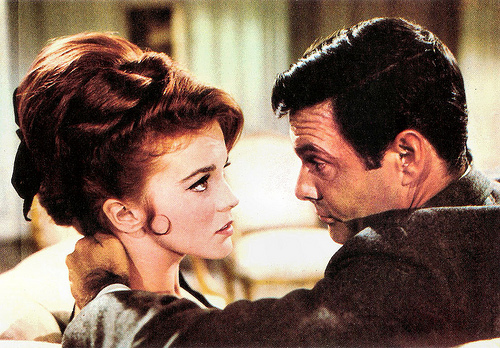
Italian postcard. Photo: Metro Goldwyn Mayer. Publicity still for Made in Paris (Boris Sagal, 1966) with Louis Jourdan .
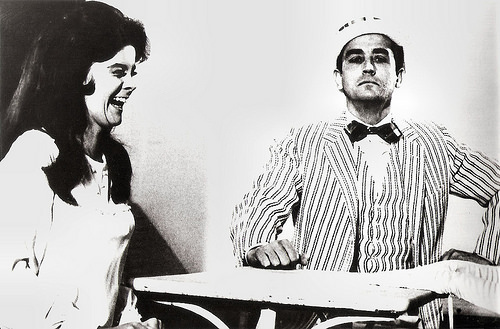
Romanian postcard by Casa Filmului Acin, no. 369. Photo: publicity still for Il Profeta/The Prophet (Dino Risi, 1968) with Vittorio Gassman .
Object of desire
As an actress, Ann-Margret is now best known for her roles in The Cincinnati Kid (Norman Jewison, 1965) opposite Steve McQueen, Carnal Knowledge (Mike Nichols, 1971) , and Tommy (Ken Russell, 1975), the rock opera film of the British rock band The Who. For her part of the over-loving girlfriend of a viciously abusive Jack Nicholson in Carnal Knowledge, she garnered an Oscar nomination for Best Supporting Actress, and for Tommy she was nominated for the Academy Award for Best Actress and won the Golden Globe Award.
During a lull in her film career in July 1967, Ann-Margret gave her first live performance in Las Vegas, with her husband Roger Smith (whom she had married in 1967) taking over as her manager after that engagement. For new film projects, she turned to Italy. Her Italian films are the comedy-drama Il tigre (Dino Risi, 1967) with Vittorio Gassman , Il profeta/The Prophet (Dino Risi, 1968), and the crime-comedy 7 uomini e un cervello/Criminal Affair (Rossano Brazzi, 1968) with Rossano Brazzi.
In 1972, she survived a dramatic 22-foot fall from a stage in a Lake Tahoe, Nevada concert. She broke an arm, suffered five fractures of five facial bones including a smashed cheekbone, and a brain concussion. 10 weeks later to the day, she was back on stage in Las Vegas. In 1979, she scored a disco hit with Love Rush. Later, she recorded the critically acclaimed gospel album God Is Love: The Gospel Sessions (2001), and an album of Christmas songs, Ann-Margret's Christmas Carol Collection (2004).
In 1982, she co-starred with Walter Matthau in the film version of Neil Simon's play I Ought to Be in Pictures, appeared with a six-year-old Angelina Jolie in Lookin' to Get Out, and played with Alan Bates , Glenda Jackson , and Julie Christie in The Return of the Soldier. On television, she starred in the TV movies Who Will Love My Children? (1983) and a remake of A Streetcar Named Desire (1984).
Other films include the crime thriller 52 Pick-Up (1986), as the wife of Roy Scheider's character. In 1991, she starred in the groundbreaking Our Sons (John Erman, 1991) opposite Julie Andrews as mothers of sons who are lovers, one of whom is dying of AIDS. A late career highlight for her was the hit comedy Grumpy Old Men (Donald Petrie, 1993) as the object of desire for Jack Lemmon and Walter Matthau.
Ann-Margret published an autobiography in 1994 titled Ann-Margret: My Story, in which she publicly acknowledged her battle with and ongoing recovery from alcoholism. In Any Given Sunday (Oliver Stone, 1999), she portrayed the mother of football team owner Cameron Diaz. In 2006, she had supporting roles in the box-office hits The Break-Up (Peyton Reed, 2006) with Jennifer Aniston and Vince Vaughn, and The Santa Clause 3 (Michael Lembeck, 2006) with Tim Allen.
In 2010, Ann-Margret won her first Emmy Award for her guest appearance on Law & Order: Special Victims Unit (2010). In total, she has won five Golden Globe Awards and been nominated for two Academy Awards, two Grammy Awards, a Screen Actors Guild Award, and six Emmy Awards. Her latest film is the upcoming American heist comedy Going in Style (Zach Braff, 2017) with Morgan Freeman, Michael Caine and Alan Arkin.
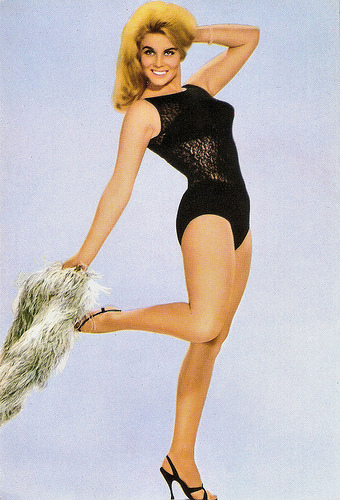
Spanish postcard, no. 100/118.
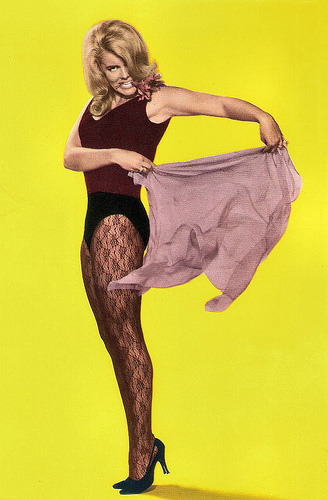
Spanish postcard by Ediciones Estes, no. 90-T. Photo: publicity still for Bye Bye Birdie (George Sidney, 1963).
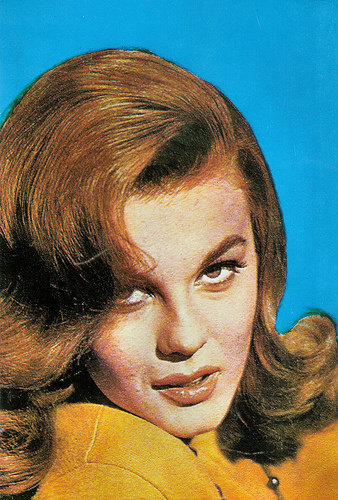
Romanian postcard by Casa Filmului Acin, no. 192.
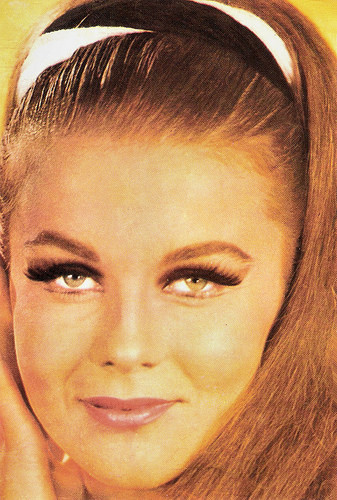
Romanian postcard by Casa Filmului Acin.
Romanian postcard by Casa Filmului Acin, no. 43 072. Photo: publicity still for the TV-movie A Streetcar Named Desire (John Erman, 1984) with Treat Williams.
Source: Wikipedia and .

Spanish postcard by Postal Oscarcolor, S.L., no. 336.

Italian postcard. Photo: Metro-Goldwyn-Mayer. Publicity still for Made in Paris (Boris Sagal, 1966).

Spanish postcard by Postal Oscarcolor, no. 018-65.

German postcard by Krüger, no. 902/250.

German postcard by Krüger, no. 902/263. Photo: publicity still for State Fair (José Ferrer, 1962) with Pat Boone.
Born in Sweden
Ann-Margret Olsson was born in Valsjöbyn, Jämtland County, Sweden in 1941. Her parents were Anna Regina (Aronsson) and Carl Gustav Olsson. Her father worked in the United States during his youth and moved there again in 1942, working with the Johnson Electrical Company, while his wife and daughter stayed behind.
Mother and daughter came to America in 1946. Her father took his daughter to Radio City Music Hall on the day they arrived. They settled just outside Chicago, in Wilmette, Illinois. She became a naturalised citizen of the United States in 1949 and took her first dance lessons at the Marjorie Young School of Dance. While she attended New Trier High School in Winnetka, Illinois, she starred in theatricals.
As part of a group known as the Suttletones, she performed at the Mist, a Chicago nightclub. The group finally arrived at the Dunes in Las Vegas. There, Ann-Margret was discovered by George Burns and soon afterwards got both a record deal at RCA. In 1961, her single I Just Don't Understand charted in the Top 20 of the Billboard Hot 100.
That same year, Ann-Margret filmed a screen test at 20th Century Fox and was signed to a seven-year contract. She made her film debut in Pocketful of Miracles (1961), with Bette Davis. It was a remake of Lady for a Day (1933). Both versions were directed by Frank Capra. Then came a remake of Rodgers and Hammerstein's musical State Fair (José Ferrer, 1962), playing the 'bad girl' role of Emily opposite Bobby Darin and Pat Boone. It was considered to be a financially and critically flop.
Her next starring role, as the all-American teenager Kim from Sweet Apple, Ohio, in Bye Bye Birdie (George Sidney, 1963), made her a major star. She became a teen idol with her role in Viva Las Vegas (George Sidney, 1964) with Elvis Presley. While working on the film Once a Thief (Ralph Nelson, 1965), with Alain Delon , she met future husband Roger Smith, known for his starring role in the private-eye television series 77 Sunset Strip.

German postcard by Krüger, no. 902/262. Photo: publicity still for State Fair (José Ferrer, 1962) with Pat Boone.

Spanish postcard by Postal Oscarcolor, S.L., no. 27. Photo: Universal Pictures. Publicity still for Kitten with a Whip (Douglas Heyes, 1964).

Spanish postcard by Productos Compactos, S.A., no. B 3789-1991. Photo: publicity still for Bus Riley's Back in Town (Harvey Hart, 1965).

Italian postcard. Photo: Metro Goldwyn Mayer. Publicity still for Made in Paris (Boris Sagal, 1966) with Louis Jourdan .

Romanian postcard by Casa Filmului Acin, no. 369. Photo: publicity still for Il Profeta/The Prophet (Dino Risi, 1968) with Vittorio Gassman .
Object of desire
As an actress, Ann-Margret is now best known for her roles in The Cincinnati Kid (Norman Jewison, 1965) opposite Steve McQueen, Carnal Knowledge (Mike Nichols, 1971) , and Tommy (Ken Russell, 1975), the rock opera film of the British rock band The Who. For her part of the over-loving girlfriend of a viciously abusive Jack Nicholson in Carnal Knowledge, she garnered an Oscar nomination for Best Supporting Actress, and for Tommy she was nominated for the Academy Award for Best Actress and won the Golden Globe Award.
During a lull in her film career in July 1967, Ann-Margret gave her first live performance in Las Vegas, with her husband Roger Smith (whom she had married in 1967) taking over as her manager after that engagement. For new film projects, she turned to Italy. Her Italian films are the comedy-drama Il tigre (Dino Risi, 1967) with Vittorio Gassman , Il profeta/The Prophet (Dino Risi, 1968), and the crime-comedy 7 uomini e un cervello/Criminal Affair (Rossano Brazzi, 1968) with Rossano Brazzi.
In 1972, she survived a dramatic 22-foot fall from a stage in a Lake Tahoe, Nevada concert. She broke an arm, suffered five fractures of five facial bones including a smashed cheekbone, and a brain concussion. 10 weeks later to the day, she was back on stage in Las Vegas. In 1979, she scored a disco hit with Love Rush. Later, she recorded the critically acclaimed gospel album God Is Love: The Gospel Sessions (2001), and an album of Christmas songs, Ann-Margret's Christmas Carol Collection (2004).
In 1982, she co-starred with Walter Matthau in the film version of Neil Simon's play I Ought to Be in Pictures, appeared with a six-year-old Angelina Jolie in Lookin' to Get Out, and played with Alan Bates , Glenda Jackson , and Julie Christie in The Return of the Soldier. On television, she starred in the TV movies Who Will Love My Children? (1983) and a remake of A Streetcar Named Desire (1984).
Other films include the crime thriller 52 Pick-Up (1986), as the wife of Roy Scheider's character. In 1991, she starred in the groundbreaking Our Sons (John Erman, 1991) opposite Julie Andrews as mothers of sons who are lovers, one of whom is dying of AIDS. A late career highlight for her was the hit comedy Grumpy Old Men (Donald Petrie, 1993) as the object of desire for Jack Lemmon and Walter Matthau.
Ann-Margret published an autobiography in 1994 titled Ann-Margret: My Story, in which she publicly acknowledged her battle with and ongoing recovery from alcoholism. In Any Given Sunday (Oliver Stone, 1999), she portrayed the mother of football team owner Cameron Diaz. In 2006, she had supporting roles in the box-office hits The Break-Up (Peyton Reed, 2006) with Jennifer Aniston and Vince Vaughn, and The Santa Clause 3 (Michael Lembeck, 2006) with Tim Allen.
In 2010, Ann-Margret won her first Emmy Award for her guest appearance on Law & Order: Special Victims Unit (2010). In total, she has won five Golden Globe Awards and been nominated for two Academy Awards, two Grammy Awards, a Screen Actors Guild Award, and six Emmy Awards. Her latest film is the upcoming American heist comedy Going in Style (Zach Braff, 2017) with Morgan Freeman, Michael Caine and Alan Arkin.

Spanish postcard, no. 100/118.

Spanish postcard by Ediciones Estes, no. 90-T. Photo: publicity still for Bye Bye Birdie (George Sidney, 1963).

Romanian postcard by Casa Filmului Acin, no. 192.

Romanian postcard by Casa Filmului Acin.
Romanian postcard by Casa Filmului Acin, no. 43 072. Photo: publicity still for the TV-movie A Streetcar Named Desire (John Erman, 1984) with Treat Williams.
Source: Wikipedia and .
Published on April 23, 2017 22:00
Paul van Yperen's Blog
- Paul van Yperen's profile
- 13 followers
Paul van Yperen isn't a Goodreads Author
(yet),
but they
do have a blog,
so here are some recent posts imported from
their feed.



